Banter Bookshop Chalk Festival




impact on students and the school.
In 2021, AB 130 implemented a “universal school meal provision” that mandated schools to provide free breakfast and lunch to any students who request them. Due to the coronavirus pandemic, many adults who lost their jobs struggled to prepare meals for their children. As the problem increased in severity, the government pushed for a free meal program for all students, expanding the US Department of Agriculture’s reim bursement for school districts to include free meals for both low-income students in the National School Lunch Program and all other students in the state. However, the free lunch program expired on June 30 and Congress did not include funding to continue the program in its latest spending bill. CA and Maine are the only states to implement a permanent universal free lunch program, whereas Vermont, Massa chusetts, and Nevada are extending the program for the 2022-23 school year.

To account for the costs of producing and serving these meals to millions of students across the state, funds in the state budget were allocated from surplus revenue from Proposition 98, which generat ed $93.7 billion in the previous year. Beginning in the 2021-22 school year, CA policymakers committed to dedicating $650 million annually to the free lunch program. According to the bill, an additional $120 million was provided to improve school kitchens.

With the loss of approximately $6 million in revenue from free school meals, the dis trict has turned to state and federal funds to maintain free breakfasts and lunches. Ac cording to FUSD, under FUSD’s 2022-23 adopted budget, funding from government sources make up more than 97% of the allotted money for the cafeteria, ensur ing that schools have adequate supplies and can a ord employees’ salaries.
FUSD’s Cafeteria Special Revenue Fund, which encompasses meal production, meal service, and the free meal program, has also seen its gross earnings rise by more than 150% in three years, largely due to gov ernment funds. Gross income increased from an estimated $6.7 million in the 2018-19 school year to more than $11 million in 2021-22 (the most recent year profits were reported).


However, the growth in revenue is accompanied by an increase in expenses associated with the operating costs of making and distributing enough food for students. Total costs for the program have increased from $6.7 million in 2018-19 to an expected $9.7 million this year. In addition, per the 2022-23 budget, food production costs are expected to exceed $3 million this year.


Since its implementation, students have taken advan tage of the free meal program, often grabbing a hot meal or snack before or in between classes. “[When] you had to pay for the food, I'd say that there was anywhere from 10-15% [of food] leftover,” Bailey-Speier said. “[Now], what's leftover at the end of lunch is basically like some sunflower seeds.”
As a part of the program, students are allowed up to two free meals a day. How ever, according to Principal Je Evans, many have the misconception that they are allowed to take all the meals MSJ o ers. Students can only get breakfast or brunch and lunch, not all three.

To enforce the school’s two-meal limit and ensure that MSJ receives the proper reimbursement from the government, earlier this year, MSJ implemented a policy that requires students to scan their ID using Minga before receiving meals. Despite leading to slightly longer wait times, policies like this keep lunch lines well-managed and meal count organized.
The drastic increase in demand for food is reflected in the number of meals produced each school year, which has jumped by more than 300,000 from the 2018-19 school year to the 2021-22 school year. With this new trend, students have noticed that the availability of pop ular meals has gone down. “I feel like the amount of each food item is di erent, and because of that, the yummy and filling food items run out the fastest,” Freshman Shahaanaa Subbian said. “That leaves a lot of people with not that much to eat.”

In addition, higher demand has also led to more food waste on cam pus. Certain lunches consist of several smaller items packaged to gether, and some of these items are thrown away or left as litter. To combat this issue, FUSD implemented a composting program in accordance with Senate Bill 1383, which aims to reduce waste. The program has put compost bins in schools, including MSJ, and has provided assemblies in partnership with the City of Fremont to ed ucate students on the importance of composting. However, “Our compost bins aren't out in the quad area or in the lunch areas, so that food is being thrown in the regular trash,” Campus Su pervisor Brandi Bailey-Speier said. “The compost situation would be a lot more e ective if people actually had the education to know how it works and make it work.”
The free lunch program provides a quick, energizing snack and convenient access to lunch for those who need it. Students no longer have to rush to pack food for them selves in the morning. “I think the free meal program has provided more access to food for the student body,” Senior Wallace Chiu said.
“It’s definitely a positive for us because a lot of students need that extra energy for school.”
“[Though the] food o ered can hypothet ically cover all of the necessary nutrition needs for students, … many students don’t get their full nutrition because they’re only allowed to take a single product,”

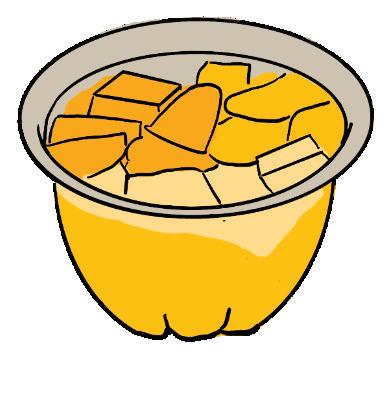

— Annabelle Sya, 11
“I get school lunch every day. I definitely think the new lunch program has a ect ed students, the free meal program has incentivized more students to grab the free lunch. It’s pretty great, but it does make the lunch lines a little longer,”
— Jerry Chang, 12

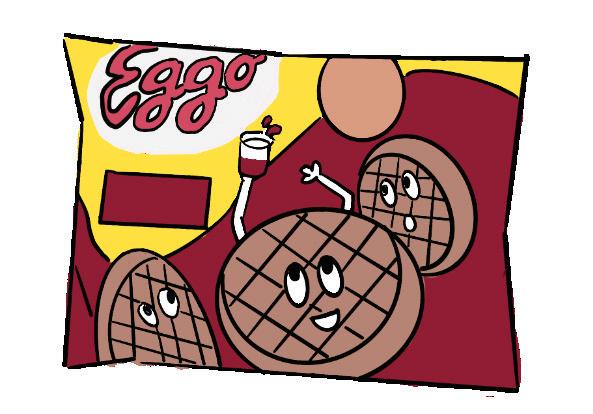
“I think the free meal program has a ect ed the [student] body positively because now kids don’t need to worry so much about lunch. It allows us to be able to get the nutrition we need and focus on school,”


— Kayona Verma, 10

“I think the free meal program lets many more students have easy accessibility to lunch. However, it does cause quite a lot more people to get lunch which can make getting food much more di cult depend ing on the location of your fourth period, causing many people to push and sprint to get lunch early,”
— Angel Li, 9
Organized by the Alzheimer’s Association, the 2022 Walk to End Alzheimer’s - Silicon Valley, CA event gathered around 1,900 participants at Excite Ballpark in San Jose. From 9:30 a.m to 12 p.m. on October 15, o cers and club members of MSJ Medcorps and MSJ Neuroscience collaborated as Team MSJ for their second year in the 2.5-mile walk.



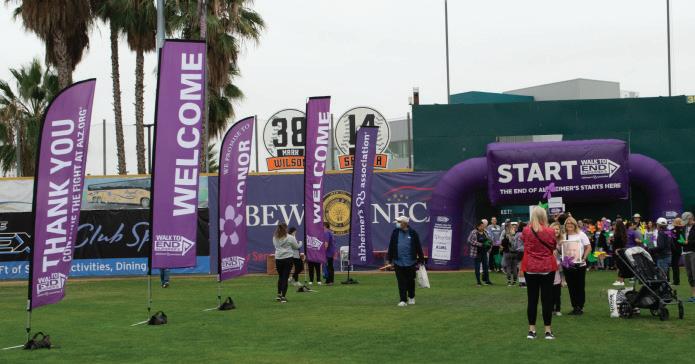

Alzheimer’s Association Founder Jerome H. Stone established the organization in 1980 with his living room support group. After his wife was diagnosed with Alzheimer’s in 1970, Stone recog nized the limited information and medical services for such diseases and was determined to make a change. “It blossomed into this amazing organi zation that’s in all 50 states across the country, and ultimately, has worked each year to fund research, care, and support, and organize advocacy e orts on behalf of those living with Alzheimer’s,” Co-Event Coordinator Zack Suggs said. After the Silicon
$1,658,225 in 2021, participants in cluding Team MSJ returned for anoth er year in the ght against Alzheimer’s.
In the beginning, MSJ Medcorps and MSJ Neuroscience were introduced to the event as an opportunity to educate the student body on the healthcare industry and engage intuitive students with the community. After observing the populari ty and success in the previous year, they decided to continue the tradition of the walk. “I love seeing all the support ... I think students want to get out there, actually ght the disease, and fundraise as much as they can,” MSJ Neuroscience Co-President Senior Rhea Ray said. In their recent collaboration, the clubs anticipate opening up “some doors for them [students]. I really hope it sparks an interest for them to receive future research and opportunities within the Bay Area on neurodegenerative diseases,” MSJ Medcorps Co-President Senior Meher Jain said.
During the opening ceremony, event or ganizers revealed the Promise Garden owers, comparing partici

pants’ perseverance in the ght against the disease to the continuous growth of owers. Each par ticipant had their own ower too — its speci c color representing a di erent message: yellow for caring, blue for ghting, purple for remembering, and orange for supporting. Before the walk, pas sion speakers also gave inspiring speeches about their connection to and battles with Alzheimer’s, including Board Member Tammy Maida. “A lot of people related to her story, and it helped convey the message of what we’re doing here today,” Senior Director Michael Castillo said.
Last year, organizers focused heavily on COVID-19, emphasizing on social distancing, masks, and hand sanitizers. While keeping those same strict safety measures this year, they wel comed a larger crowd — strong in spirit and en couragement. rough their constant advocacy, the participants fueled each other’s energy, chant ing signi cantly louder than the years before.
Along with holding owers, participants wore customized
rated posters honoring their loved ones. Several MSJ students identi ed with them, having also lost loved ones to Alzheimer’s. “My great aunt passed away from Alzheimer’s. [When] some one you knew and loved could have this sort of a iction, it really impacted and motivated [me] to learn more about neuroscience,” MSJ Neu roscience Co-President Senior Yash Kilam said.
“The most memorable moment was when we got to the fnish line and everyone was clapping and whistling for us — it felt like we ac complished a huge milestone.” -MSJ Neuroscience Co-Activities Coordi nator Junior Yuvraj Walia
As the event neared the end, “the most mem orable moment was when we got to the nish line and everyone was clapping and whistling for us — it felt like we accomplished a huge mile stone,” MSJ Neuroscience Co-Activities Co ordinator Junior Yuvraj Walia said.▪

On October 8, MSJ’s Marching Warrior Band performed in the 19th annual Olive Festival, re turning to the event after a two year hiatus. Lo cated in an olive grove behind Fremont’s Mission San José, the event featured a variety of products sold by local vendors. Consisting of more than 190 performers, the band provided live enter tainment for spectators, playing hit tunes such as “Toxic” by Britney Spears and their competition march, “The Boys of the Old Brigade” by William Paris Chambers. “It [was] a great opportunity to play for the community, and we have spread the goodwill of the band and our high school through out,” Marching Band Director Monica Kraft said.
Fremont Places as the 17th Safest City Na tionwide
On October 10, WalletHub released a ranking of 2022’s safest cities in America, in which Fre mont was 17th. This comes after being ranked the happiest city in the US by WalletHub. To score the cities, WalletHub used 42 key indica tors under three different criteria: home and community safety, natural-disaster risk, and fnancial safety. Overall, Fremont received a total score of 79.98 — its highest rank being ffth in fnancial safety. Additionally, Fremont has the third lowest percentage of the unin sured population below the age of 65, sitting at 2.4%. This makes Fremont the safest in CA with Irvine following closely behind at 26th.

On October 12, President Joe Biden designat ed Camp Hale in Colorado as his frst national monument under the Antiquities Act. During World War II, Camp Hale was used as a train ing ground for alpine warfare. Now, the more than 50,000 acres of protected land serve as a sanctuary for wildlife such as elks and lynxes. “This action will honor our nation’s veterans, Indigenous people, and their legacy by protect ing this Colorado landscape,” the White House said in an offcial statement. In the future, Biden’s administration plans to further protect more than 200,000 acres of land in Colorado’s Thompson Divide from mining and gas drilling.

After the death of Mahsa Amini in custody of the Iranian morality police, protests ignited to denounce the country’s clerical government. Amini was arrested for wearing her hijab loose ly, and citizens across the country have banded together, expressing their desire to overthrow Iran’s current government. Protestors are cut ting their hair in public and chanting sayings such as “women, life, freedom.” In response, Supreme Leader of Iran Ayatollah Ali Khame nei has denounced the protests as “scattered riots” attempting to undermine the Iranian government. Protesters have incurred police retaliation. However, many remain undeterred.

More than 100 MSJ alumni gathered in Santa Cruz to celebrate 40 years since their graduation.
From October 7-9, more than 100 alumni from MSJ’s Class of 1982 gathered in Santa Cruz to celebrate the 40th year since their high school graduation. roughout the event, alumni social ized over food and drinks and shared anecdotes about the past and their plans for the future. e event also included a remembrance of classmates who had passed away in recent years.
For the main event organizer, 1982 Alumna Lori Cahill, the most di cult hurdle was nd ing contact information for her classmates. Using LinkedIn, Facebook, and word of mouth, they reached 200 people out of a class of 400. “As peo ple signed up, I would take those people and use them as recruiters … because sometimes it just took that personal invitation to make [people] want to come,” Cahill said. To gather information about people’s preferences, Cahill interviewed the organizers of prior reunions and sent an online

survey to her former classmates. Hoping to set a leisurely mood for the event, she created the theme of a “Seaside Shindig” in Santa Cruz.

“I would take those people and use them as recruiters … because some times it just took that personal invita tion to make [people] want to come.” -1982 Alumna Lori Cahill
Although the formal reunion started on Sat urday, about 30 attendees met at a Santa Cruz plaza on Friday night to kick start the reunion with live music and food venues. e following morning, the alumni gathered on the boardwalk to enjoy the Monterey Bay beachfront. “We all met, and … people wanted to go and ride the Giant Dipper. A lot of [them] were afraid to do it, but we had a great time, we all went there and kind of goofed o ,” Cahill said.
e main highlight of the weekend took place at the Dream Inn. Listening to nostalgic hits by KC & e Sunshine Band, Earth, Wind & Fire, Queen, and other popular bands from their high school years, the alumni bonded and caught up with classmates they hadn’t seen for decades. “Many of us grew up together in Fremont … It was wonderful to reconnect [with] the kids I knew in kindergarten that I graduated with in high school,” 1982 Alumna Brenda Logan said.
“Many of us grew up togeth er in Fremont … It was wonder ful to reconnect [with] the kids I knew in kindergarten that I graduated with in high school.”



-1982 Alumna Brenda Logan
Re ecting on their time at MSJ, many alum ni recalled their class traditions, some of which MSJ students still celebrate today. Similar to this year’s Homecoming, the Class of 1982 also brainstormed overall themes, organized dressup days, and stayed up all night decorating the amphitheater before their class performances.
rough their class spirit, they won Homecom ing Week three times in their freshmen, sopho more, and senior years. However, their Home comings included more traditional aspects not seen at MSJ today, including football games, which Cahill found regretful. “[Our] alumni [would] come home for the week and go to a game, and they don’t really do that anymore,” she said.
After attendees had socialized for a few hours, event organizers played a video they had com piled of alumni who couldn’t attend. e alum ni gave updates on their lives, allowing attend ees to reconnect with them despite not seeing them face to face. Afterwards, attendees played
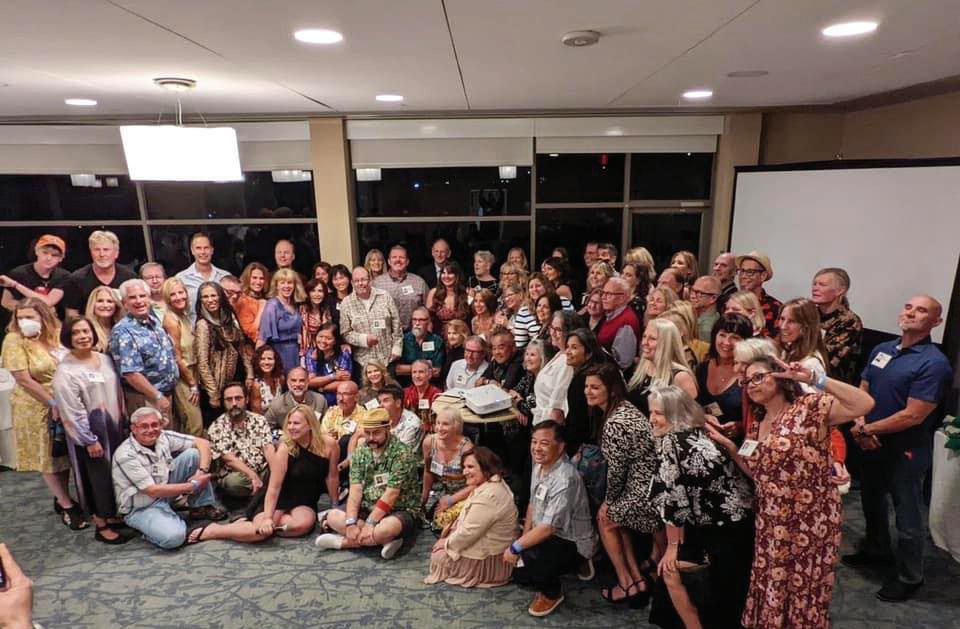
Reunion Jeopardy, a trivia game in which they guessed popular shows and famous Warriors from clues. Attendees eagerly partook in the game, call ing out answers impromptu as they reminisced about MSJ.
Later in the evening, they watched a video trib ute to deceased classmates, compiled by Cahill. e tribute included quotes from people close to each alumnus, as well as major accomplishments throughout their lifetimes. “Our freshman and sophomore class presidents have passed away ... everyone knew and loved the people who are in that video,” Cahill said.
Following the remembrance, Class of 1982’s class counselor Dave Duncan shared the memo ries from his time at MSJ and told attendees to cherish this moment with each other. Finally, alumni explored the “memorabilia tables,” where attendees had laid items from their time at high school. ese included old photographs, school merchandise, past issues of the Smoke Signal, con cert tickets, and notes people had forged to skip class.
“It was nice to connect with people you’ve known your whole life, and still share the same background and values and dreams ... Take time to enjoy the moments, because it goes by so fast, but they’ll be very special.”
 -1982 Alumna Lori Cahill
-1982 Alumna Lori Cahill
As the event came to a close, attendees gave heartfelt goodbyes and expressed their enthusi asm for the next reunion. “It was nice to connect with people you’ve known your whole life, and still share the same background and values and dreams ... Take time to enjoy the moments, be cause it goes by so fast, but they’ll be very special,” Cahill said. ▪
Woke washing is a form of unethical activism where companies use social issues to make a pro t, seemingly the perfect way for hypocritical compa nies to cover up exploitative practices while simul taneously increasing sales. Every June, countless companies partake in woke washing, splattering rainbows over their social media platforms in hon or of Pride Month — only to ignore the LGBTQ+ community after the month ends. As brands in crease their outreach through platforms online, corporations have made further e orts to pro t o of consumers’ concerns for ethical consumption. Brands present a facade of awareness and care for social issues like diversity, environmentalism, and feminism, but their e orts often rub o as per formative simply for corporate gain, rather than social bene t. On the other hand, brand activism refers to when brands genuinely promote or drive change that aligns with their values. e line be tween brand activism and woke washing is drawn when companies engage in performative activism while putting up a front of creating a meaningful impact.
In the modern social context, woke washing is a product of marketing tactics for businesses that inherently value income. ough such goals are impossible to change, businesses must put greater e ort into following through with the promises they make in their advertising — a change which not only brings greater awareness to humanitarian issues, but also monetarily bene ts the company through boosting public opinion. For example, ice cream company Ben & Jerry’s is no stranger to incorporating brand activism into their ice cream avors. In 1988, the brand released the Peace Pop, an ice cream stick whose sales would fund 1% for Peace, a non-pro t that funds peace-promoting activities and projects by redirecting the nation al defense budget. More recently in 2019, Ben & Jerry’s partnered with multi-racial activist group
the Advancement Project to release Justice Re Mix’d, a limited edition avor whose proceeds would go towards supporting criminal justice reform. In an interview with Hu Post, Director of Marketing for B Lab US and Canada Veena Harbaugh said, “[Ben & Jerry’s stands] out for the breadth and depth of their positive impact ... leading collective action groups and helping businesses wake up to their responsibility in cre ating racial justice.” With Ben & Jerry’s massive industry outreach, their large-scale campaigns serve to build public awareness, while adding to a positive brand reputation due to their com mitment to solving the problems they advocate against. e brand does not only make e orts to engage in movements in the current public eye, but also to abide by the core values it is built upon.
In the modern social context, woke washing is a product of marketing tactics for businesses that inherently value income.
In another example, in response to wide spread controversy surrounding immigration, fashion brand Jigsaw launched their “Love Im migration” campaign in 2017 to celebrate the diverse cultures their clothing draws inspiration from. Crucially, Jigsaw’s practices align with their public message with a workforce comprised of employees of 45 di erent nationalities. Rath er than presenting a facade of concern for social issues, Jigsaw encourages a working environment which supports employees from all ethnical and national backgrounds, properly advocating for the social cause they stand behind. Genuine e orts toward change do not go unnoticed by the public, not only boosting brand image and long-lasting, ethically earned pro t, but also awareness towards such humanitarian issues.
Considering popular brands’ in uence on the market and consumers’ perception of cur rent issues, it is vital for them to speak out and



take action against crucial social matters. How ever, a line should be drawn when brands place themselves on a moral pedestal but still engage in the very practices they condemn. For exam ple, multi-billion dollar fast fashion company H&M’s sustainability marketing ploy is spear headed by its sustainable clothing line called the Conscious choice collection. But, H&M fails to mention it operates under a fast-fashion business model, which means it mass produces thousands of pieces that are dumped into land lls. A Quartz investigation found that contrary to H&M’s greenwashing statements, only a percentage of its pieces are recycled and its clothes take large amounts of water to create. Due to the green washing, consumers are lured into the facade of an environmentally-friendly company. e consumers give their trust to the company and not only purchase its products, but also buy into the idea that their actions are helping the great er good. Woke washing companies like H&M deceive their customers as their products are not actually sustainable, fostering a lack of trust be tween the two parties this can leave consumers skeptical to ploys and lead to true sustainable brands being harmed in the process.
Sportswear brand Nike succumbs to the pit falls of hypocrisy and woke washing by using social campaigns to cover up internal company issues. In 1991, workers’ rights activist and au thor Je Ballinger published a report exposing Nike’s poor working conditions, from low pay to cramped, re-hazardous buildings. After receiv ing signi cant public criticism, Nike established a department to improve the lives of its workers primarily in terms of altering wages. However, in 2017, Nike removed itself from the Worker Rights Consortium, meaning they could no lon ger be monitored for their working conditions. Since then, Nike has been releasing more progres sive and socially aware advertisements to make up for its lack of transparency with its working conditions. In light of recent xenophobic attacks,
Nike aired a campaign with the hashtag #StopA sianHate, aligning themselves with the Asian com munity. However, according to Reuters, most of Nike’s factories are in Indonesia, Cambodia, and Vietnam, where workers are paid 45-65% below living wage. While Nike advertises itself as social ly aware and tugs on consumer empathy to make pro t, the company still refuses to provide proper working conditions for its exploited Asian work ers. Nike blatantly participates in performative activism by advocating for the better treatment of Asian people, while actively oppressing the Asian community by placing workers in harsh environ ments to produce their products.
Authenticity is rare among an ocean of dis ingenuous advertising, originating from the goal of adapting to an audience concerned with mod ern social issues. us, consumers have a moral responsibility to be informed on the goods and services they purchase in order to condemn hyp ocritical branding. Although sustainable shopping is often more costly than fast-fashion, bringing awareness to harmful industry practices will en courage nancially privileged individuals to re consider their purchasing habits. Consumers can research company policy online through sites such as goodonyou.eco and Global Witness, which provide information on companies’ ethical prac tices and their contribution to the environment. As consumers, we have the power not only to bet ter working conditions for all employees, but also to help solve the humanitarian issues that plague modern society. ▪
Bhagat,
Esther Lau, Annika
Julia Peng, Elton Yu

Christy Huang, Angela Xiong
A&E Sanah Bhardwaj, Joanne Park SPORTS Karina Han, Kaitlyn Wang
GRAPHICS Sarina Li, Hannah Shen WEB Jennie Wang, Bryan Xiong
TECH Chahak Gupta, Jason Tang BUSINESS Chloe Gao, Sahas Goli
CIRCULATION Elaheh Khazi, Amy Luo ADVERTISING Annie Xu, Aaron Zhou EVENTS Andria Luo, Nessa Tong
Goonja Basu, Angelina Chen, Novak Chen, Ruhani Chhabra, Tanvi Deshmukh, Tushara Devapatla, Anandita Devata, Jiyun Guo, Jacob Han, Sally Han, Sarah Hu, Shuhan Jin, Ayushi Kashyap, Vedesh Kodnani, Keerti Koya, Abha Kulkarni, Waylon Li, Kaylee Liu, Maryam Naseer, Ashley Pang, Daphne Senecal, Priyanka Shah, Vidyuth Sridhar, Praamesh Siva, Aaryan Suri, Katie Tang, Anushka Vasudev, Amelie Wu, Lucy Yao, Callie Yuan
ADVISER Sandra Cohen
Send letters to the editor to opinion@thesmokesignal.org

Letters under 300 words may be considered for publica tion and must include a full name and school af liation. The Smoke Signal reserves the right to edit for clarity and length.
To advertise in the Smoke Signal, email ads@thesmokes ignal.org. Advertising that is included on the pages of, or carried within, the Smoke Signal, is paid advertising, and as such is independent of the news and feature content.

The Smoke Signal ’s right to freedom of speech and press is protected by the First Amendment of the Constitution.
To stay updated with our online content, see our Facebook page at https://www.facebook.com/msjsmokesignal.
All policies on distribution, corrections, and bylines can be found at www.thesmokesignal.org/about.
A couple of weeks ago, while standing in line for a chicken platter at e Halal Guys, a friend asked about my opinion on Netf lix’s newly released Partner Track, starring Arden Cho. Despite loving the lead actress and nd ing the show’s plot interesting, I found myself saying, “Oh my god, I hated it.”
Within the rst half of episode one, the protagonist’s (Ingrid Yun) identity as one of the only women of color in her workplace was em phasized multiple times. ough I’m eternally grateful for Partner Track ’s contribution to the posi tive trend of female Asian stories in American media, I’m tired of being represented by a character known as the “diversity card” in their workplace or school. In grid's multifaceted personality is covered up by the overwhelming emphasis on her character being diverse, making the show unin teresting to watch.
When these stereotypical di versity tropes are repetitively displayed in the media, it lowers individuals’ self-esteem — no one wants to be a poster child for di versity at a company or have their identity reduced to their race. When I watched season two of Bridgerton, I was able to follow the character’s (Kate Sharma) journey instead of following her heritage. Kate’s witty personality works in tandem with her South

Asian identity — she wears gor geous jhumkas (earrings), refers to her father as ‘Appa,’ and regularly oils her hair, but her personality isn’t overshadowed by her cultural background. e rest of the char acters in the show don’t see Kate and her family as ethnic women — to them, the Sharmas are the new, beautiful, and marriage-eli gible family in town.
Growing up in a predomi nantly-Asian area, I've never been viewed as “ethnic” or “diverse” — I'm just myself. However, outside of the Bay Area and MSJ bubble, people tend to de ne me by my heritage. My South Asian identity becomes the pivotal point of my personality, making me feel that my race holds more value than my capabilities. When shows and movies depict storylines revolv ing around race and “diversity,” people are reminded of the over whelming in uence culture has on the way they are perceived by society.
It’s important for the media to represent well-rounded characters of color that experience emotions and struggles that don’t necessar ily relate to their racial identity. Diversity is important — in fact, we need more of it in American media, but it's crucial to have characters whose storylines pay homage to their culture without making it the center of their per sonality. ▪
Trigger warning: Mentions of trau ma and mental illness
is editorial contains mentions of emotional trauma and mental illness. Because of its sensitive nature, these topics may trigger strong emotions in students. Please proceed with caution and reach out to MSJ counselors or a trusted adult if you or a student you know needs support.

“Someone gives you a silent treat ment, and suddenly [you feel like] you’re 13 again sitting on the couch while your parents walk around the house not speaking to each other,” said a TikTok user in a video that has been viewed more than 650,000 times since September 26. During the past month, thousands of TikTok users have made similar posts cen tered around the lingering impacts of negative childhood experiences, ranging from feeling excluded in past friend groups to mental illness and abuse. Originating on social media, these posts indicate the need for se rious conversations surrounding the weight that past traumas can hold in our present lives and how we can fully heal from them.

According to the Substance Abuse and Mental Health Services Admin istration under the US Department of Health and Human Services, trauma is de ned as any “event or circum stance with lasting adverse e ects on the individual’s mental, physical, and emotional health.” e issues we ex perience during our formative stages of life can often leave us with scars, fears, and phobias that seem di cult or impossible to heal, and many of us are left to struggle with the e ects
through adolescence and adulthood. As high schoolers, students are not only beginning to navigate adult hood with additional responsibili ties and obligations, but they’re also starting to understand and reevaluate these childhood events.
At MSJ, the culture surround ing toxic productivity and delayed grati cation leaves little to no room for meaningful discussions surround ing trauma recovery and can create a harmful environment for individuals in their journey towards self-accep tance and healing. From students neglecting self-care for assignments to classmates pressuring one another to take the most rigorous courses, the current MSJ environment rein forces the message that unhappiness and emotional stress for the sake of academics is a necessary sacri ce and bene cial towards students in the long run. is mindset directly translates into MSJ students’ tenden cy to suppress negative emotions and memories for the sake of productivity and conformity — a dangerous pipe line that can have adverse impacts on a person’s future wellbeing.
According to the Keck School of Medicine at the University of South ern California, the e ects of trauma can range drastically in severity; some may not require rapid interven tion, whereas others may endanger one’s immediate wellbeing. Because of this, when triggers continue to ap pear in a person’s life, at school or af ter graduation, trauma repression no longer becomes an e ective coping method. is is especially true if that event took a large toll on your physi
cal, mental, or emotional wellbeing. Repression is not recovery, and when students avoid their traumas, inten tionally or not, they are only delaying the healing process rather than skip ping over it.
As a community, MSJ needs to help students learn to prioritize emo tional wellbeing over toxic productiv ity and emphasize the use of trusted resources for mental support. e stigma around asking for help and using the resources provided should be changed by teaching students to adjust their mindset. At an individ ual level, implementing mindfulness into daily routines can help students become more aware of their thoughts and emotions and understand the reasons behind harmful ones, al lowing them to seek intervention more readily. Although recent in stallations like the Student Wellness Center are a step in the right direc tion, MSJ should set up more acces sible resources for students in need of mental or emotional assistance. For instance, on-site therapists at MSJ have sparse openings, with many stu dents remaining on a waiting list for months at a time just to speak with a mental health professional. rough community discussions and mutual support, we can shift MSJ’s discourse surrounding trauma and mental health to something that must be pri oritized now rather than later.

When prompted to name “the greats” in sports, most people would probably say Simone Biles, Michael Phelps, or Tiger Woods; in the industry, Warren Bu ett, Bill Gates, or Steve Jobs. ese names that come to mind are known for their competitive or monetary suc cess, but what is greatness, and is chasing greatness possible?
In our capitalistic society, indi viduals are often raised with suc cess as an end objective, de ned by educational or career achieve ments, wealth, or the like. Condi tioned to believe that conventional modes of success are what make greatness, we’re taught to structure our lives around illusive goals, of ten ending in disappointment or disillusionment. Especially in the Bay Area where a majority of fami lies are rst or second-generation immigrants, these traditional de terminants of success are heavily emphasized because they’re what allowed our families to build their lives here.
Recently, there’s been a lot of pushback on these ideas — for good reason — particularly from Gen Z. But, I’ve found that the narrative has shifted to one that deems the chasing of greatness as a toxic, unachievable, and non existent pursuit, rejecting the decades-old mindset in an allencompassing way. While done with the intention to break down “hustle culture,” this often causes

more harm than good, holding us back from fully embracing oppor tunities that come our way. (For more on this, read “Gen Z’s Labor of Love” in Vol. 57, No. 9 of the Smoke Signal .)
Personally, I’ve gone through di erent phases surrounding suc cess and output. At one point, I was completely sucked into “hustle culture;” at another, I completely removed focus from my goals and lived day by day, which although was needed at the moment, proved to be unsustainable and direction less. Over time, however, through experiences that weren’t conven tionally successful but still all the more ful lling, I’ve grown to re alize that chasing greatness can be attainable and healthy. Instead of subscribing to societal ideals of what it should be, we should rede ne greatness by seeking it in the journey.
Of course, this doesn’t mean you should stop chasing after your goals and visions. Whether or not you’re a goal-oriented individual, having a target is helpful, and we should continue to set goals for ourselves, whether big or small. At the same time, however, it’s impor tant that we work towards peace ful acceptance when things don’t pan out in the way we originally imagined. Ultimately, greatness isn’t what we achieve — it’s the intention to grow throughout our journey. ▪
By Kaitlyn Wang & Nessa Tong Sports Editor & Sta Writer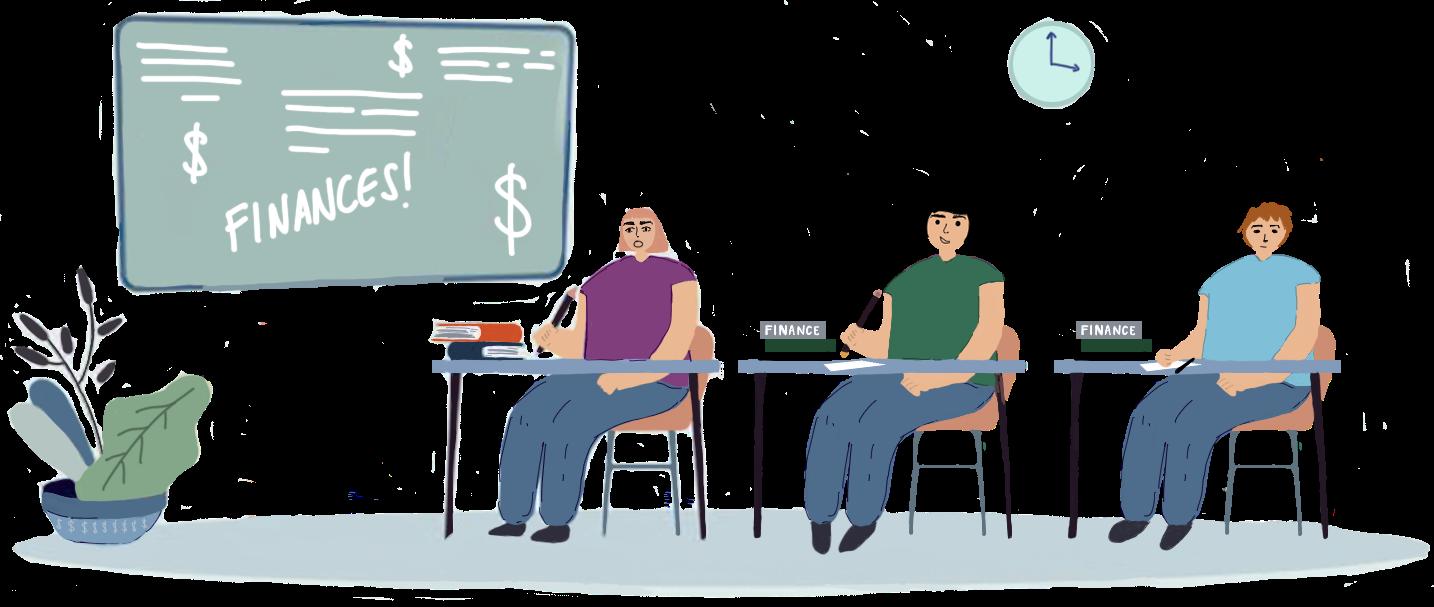
 By Angelina Chen, Anandita Devata, Jacob Han & Anushka Vasudev Sta Writers
By Angelina Chen, Anandita Devata, Jacob Han & Anushka Vasudev Sta Writers

Financial literacy involves the knowledge of fnan cial skills, as well as the ability to apply them to realworld situatons. This includes a wide range of topics such as investng, personal fnance management, un derstanding loans and debt, and maintaining fnancial security. Educaton in this topic comes into play when students apply for part-tme jobs in high school, navi gate college expenses, or pay day-to-day bills. Given the current economic climate, with college fees and student debt rising, it becomes increasingly cru cial for students to focus on fnancial educaton. An analysis from Fortune found that in February, the US faced record-high student debt, exceeding $1.75 tril lion, emphasizing the dire need for high schools to teach students to manage their money and pay of loans on tme. A study by scholars at Tulane Univer sity and the University of Massachusets Amherst in dicates that 38.2% of low-literacy students underest mate future payments by more than $1000 annually, while high fnancial literacy reduces the probability of signifcant payment underestmaton by 17–18 per centage points. This correlaton highlights that a lack of fnancial knowledge not only afects a student’s ability to pay college fees but also has teenagers struggling with snowballing expenses, from groceries and school supplies to dorm furniture. Navigatng all these diferent aspects of adult life without a founda ton in fnance can lead to unwise spending decisions and poor money habits, all of which make paying of college loans and handling necessary living expenses even more difcult.
However, the implementaton of fnancial literacy in educaton has the potental to address these prob lems. For instance, states like Georgia, Texas, and











Idaho require students to take a personal fnance course that covers topics such as handling bank ac counts and completng loan applicatons. Responses were overwhelmingly positve: three years post-im plementaton, credit scores, a numerical value that predicts how likely someone is to pay back a loan on tme, which can afect interest and mortgage rates, increased and severe delinquency rates decreased. These students have contnued to exhibit beter f nancial decision-making capabilites. According to a study from the Financial Industry Regulatory Au thority, college-bound students are more likely to apply for fnancial aid, have re duced loan balances, and have beter credit scores. Improved fnancial planning allows for beter control over one’s money, making it easi er to set aside amounts to create an emergency fund and pay bills on tme.
Despite the benefts of universal fnancial educaton, many feel that teaching fnancial knowl edge to students is a parental responsibility. How ever, a study from the American College of Finan cial Services showed that 80% of adult respondents scored 60% or lower on fnancial questons regard ing retrement. Although they may have some expe rience in many of the subtopics in fnancial literacy, many parents do not necessarily understand the top ics very well either. If adults themselves lack fnancial literacy, it is impractcal to hold them responsible for teaching their children this informaton.
Others argue that implementng year-long or se mester courses at high schools can rip a hole in school
“[With fnancial courses], I would feel a lot more confdent entering the real world. Especially with the reality of student loans setng in, I’d be a good deal less anxious. I also think it would help some students learn a bit more about their interests, as fnancial courses aren’t taught at Mission. Plus, these life skills would make me feel a bit more prepared for life afer school ing.” — MSJ DECA Vice President of Leadership Zoe Lee, 11
“Financial literacy is really important because it provides individuals with indepen dence and power. You will have your own destny in your own hands, and fnancial literacy is something that you will use your entre life.” — Entrepreneurship & Eng lish Teacher Valerie Caratni
districts’ tght budgets, adversely afectng core areas of educaton. When funding for educatonal insttu tons is already stretched to its limit, thinning the reach of federal and state budgets on an additonal course seems to be unjustfed. However, fnancial educaton does not necessarily entail budget-draining ideas. Incorporatng short fnancial lessons in math or social science classes will teach fnancial knowledge to students without taking tme away from other subjects. In social science classes, where economic recessions and fnancial setbacks are discussed, having teachers encourage students to consider the implicatons those events have on pub lic fnancial knowledge can stmu late meaningful conversatons in classrooms about the importance of maintaining fnancial habits.
Outside of the classroom, there are many opportunites for students to fur ther their fnancial literacy. For example, in MSJ, many clubs such as DECA and MSJ In vestment Club prioritze fnancial literacy and provide students with opportunites to exercise their fnancial knowledge. Students may also look towards external organizatons like Operaton HOPE and Financial Be ginnings. Even those who fnd it difcult to set aside tme to partcipate in these organizatons can stll learn through online apps, podcasts, or books such as I Want More Pizza and How to Money: Your Ultimate Visual Guide to the Basics of Finance. To ensure a bright er and more stable future for millions of teenagers, both students individually and school systems as a whole must take initatve to prioritze and expand their fnancial knowledge.
“There’s a very serious need for fnancial educaton, but not many consider it to be a big problem, which is why we haven’t made much progress on it. It’s about practcing and actually stcking to it. It’s like being on a diet; nobody wants to be on a diet, so they need that motvaton. You can think of fnancial literacy as a diet for your money; how much are you going to spend in any one given month?”
— MSJ Investment Club President Rahul Rangaraaj, 12
“I think [fnancial workshops or courses] would be helpful. There’s two kinds of challenges, but it doesn’t mean we can’t overcome them. The frst one is that we’d have to have a minimum of 30 students sign up for the course whenever we run a new class. The second is you have to get a teacher who’s fnancially literate themselves. The third challenge to our populaton is that it’s so hard to run a new class here if it's not AP-level. We always try to run these cool classes but students don’t want to sign up for them unless they’re AP.” — Assistant Principal Jeana Nightengale
“I think fnancial literacy classes would be a good idea, because in school we don’t have any classes on how to deal with adult problems, like fnances. To have a class to teach us important lessons we need to use in our adult life would be very helpful.”
— Meghna Goswami, 10
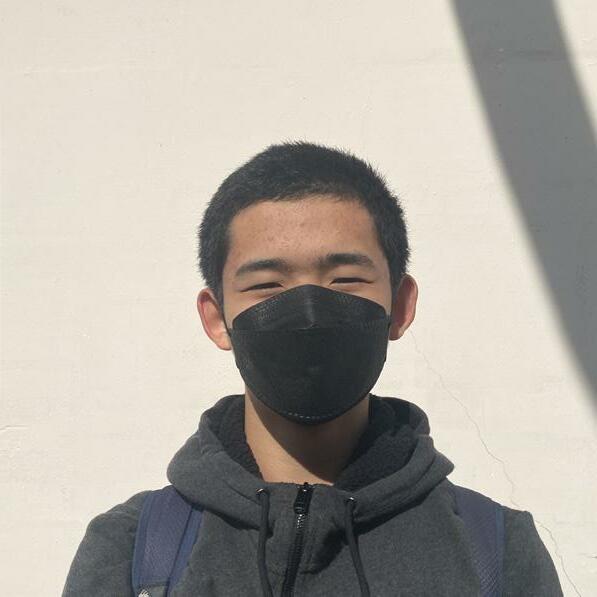
Earlier this month, the CA Department of Educaton refused to release this year's Smarter Balanced (SBAC) test results, hoping to delay the assumed poor results untl afer the November electon. Now, afer signifcant pushback, they are plan ning to release results sometme at the end of October. Do you think the state made a right decision by withholding scores, or do you believe that they should have been transparent?

"I don’t think the California Department of Educaton has a good reason for withholding SBAC test results and should be transparent with the public. A decline in test scores is expected because of the pandemic, so delaying the release of test results isn’t going to make much of a diference. It only causes harm by withholding data that schools can use to know what areas to improve on right now."
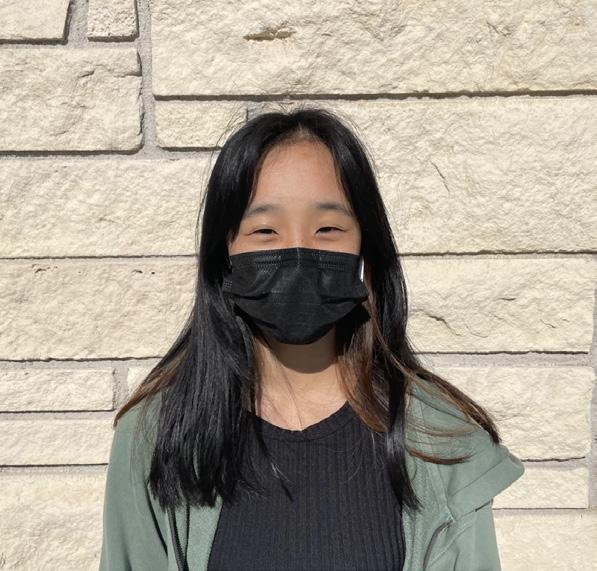
"The state absolutely should have been transparent instead of withholding scores. It's the duty of the government to do the best for the people, and withholding scores for politcal gain was incredibly unethical. In additon, the government fails to take into consideraton students who may want to see their score to see their progress through the years. As someone who has scored well on the SBAC, I want to be able to see if I am able to consistently achieve this. Overall, the state has failed to take into consideraton the voice of the people, and this decision will likely lead to an even poorer image for them in the upcoming electon."
“I believe that scores should be released the moment that they’re available. The Department of Educaton already knows that the results are bad, and they are purposely holding back these scores for their personal beneft: whether it’s related to swaying electon decisions or even just saving a bit of face. They should’ve been transparent from the start, and it’s deserved that the department’s poor decision was met with negatve feedback.“






 By Goonja Basu, Priyanka Shah, Katie Tang & Lucy Yao Staff Writers
By Goonja Basu, Priyanka Shah, Katie Tang & Lucy Yao Staff Writers





The arrival of autumn means all things fall-flavored. This month, the Smoke Signal’s DieHard TryHards decided to see who could make the most a-maize-ing autumn bagels and spread. With high tensions and drama worthy of a soap opera, Smokies go head to head to see who exactly will reign supreme as the pump-king of bagel-making.
Having lived in New York, the home of bagel-lovers, I know what the true meaning of a perfect bagel is. I apple-aud my fellow Smokies’ ef forts, but my schmear knowledge of the bagel anatomy will knock down any competition. The combination of flavors I have con cocted will definitely spice things up, and I am going to make the best bagels out there. Fall-elujah –– it’s finally my time to shine!



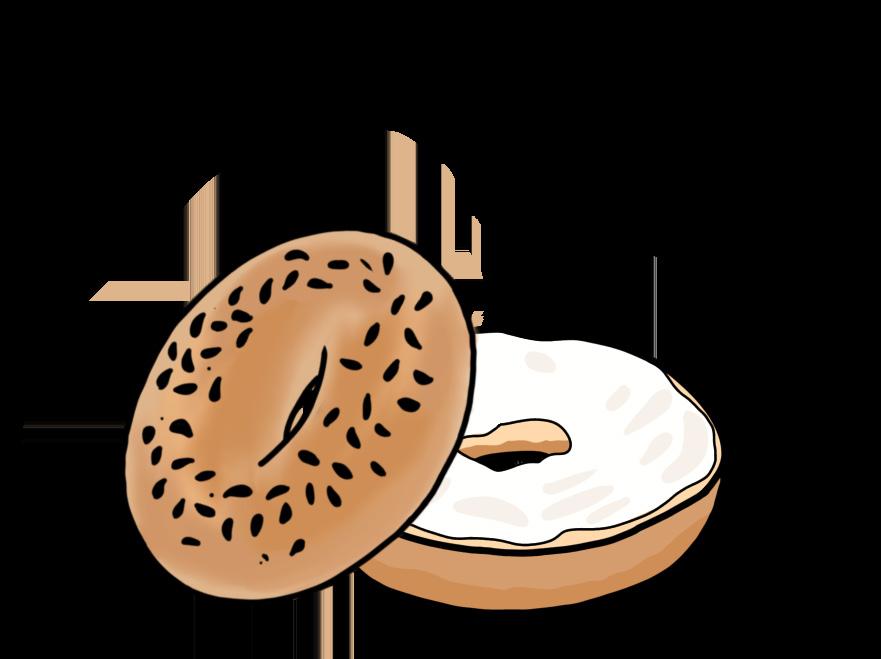
When it comes to bagels, I don’t mess around. With 16 years of ba gel-eating experience up my sleeve, I totally be-leaf that I am the most knowledgeable bagel connoisseur here. I spent hours finding the per fect bagel recipe to follow. Despite the three fires I set, I have complete faith in my skills and oven. All the other Smokies can try to beat me, but there is no doubt in my mind that at the end of the day, my in-fall-ible bagels and I will come out on top.

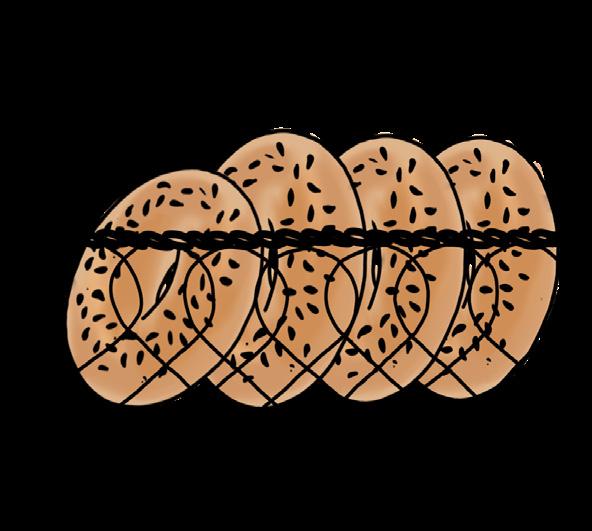
Personally, I believe that I have been robbed of a win. My rosemary garlic bagels with artichoke cream cheese were just too advanced for anyone’s taste pallete. Hours of contemplating fla vors and exotic ingredients was a win in my mind. However, at least I can say that I successfully made a bagel completely from scratch. They just needed a little bit of pump kin-patching up. Next time I take on bagel making, the taste and tex ture will not fail me, and people will definitely be in line for my bagels.
Well, what can I say? Com ing into this competition, I knew my bagels were the diamonds of the season — none of my other competitors even stood a chance. Next time you see me, I’ll be walking down the red carpet with my spice-tac ular bagels and spread. I am so re lieved that all of my hard work paid off. After hours of kneading, mixing, baking, and chilling, my bagels lived up to their fullest potential. These ba bies were not only pretty but also had some next-level flavor, making them number one in everyone’s hearts.
As a daily consum er and avid lover of bagels, I believe I will absolutely demolish my fellow Smokies. Unlike my competitors’ gravely boring cre ations, my bagels are going to grace the earth with how gourd they taste. Sure, it’s my first time making ba gels, but you know what they say, first time’s the charm. My days of somewhat subpar baking are over, it’s time to turn over a new leaf. B-autumns up!



Looking at my competi tion, I’ll be lucky if I get an apple-y ever after with this one. Yeah sure, baking can be the ap ple of my eye, but bagels aren’t as easy as pumpkin pie. Hopefully one of the two baking channels I follow will upload a gourd-geous collection of fall treats that I can casually take heavy inspiration from. For now, I’ll be Googling “How to knead dough” and preparing eight fire extin guishers, then just hop ing something edible comes out in the end.
Listen, I tried my best. I may have completely lost, and there’s no chance I’ll be on Top Chef any time soon, but I can now call myself a professional baker. The experience of trying to open a can for half an hour, feeling pumpkin pu ree under my fingernails, and dusting my countertops with a gross amount of flour and cinnamon was arduous, but I feel accomplished. Six hours of hard work later (when the recipe said it would take two and a half), these bagels are the best in my heart, al though maybe not in my stomach.
Considering the fact I was fully expecting tenth place in a competition of four people, I’d say I surpassed my ex pectations. I guess remaking the caramel three times was actually worth it (and totally not because I burned it each attempt). Although I won’t be going on The Great Brit ish Baking Show anytime soon, I’ve definitely gained some confidence in my recipe-following abilities. Even if it takes triple the time and triple the dirty dishes, you know what they say: just bake it till you make it.

As Halloween creeps upon us, many bring out their spookiest stories to tell their friends and family. The Smoke Signal has compiled some of the most popular Halloween tales and where they came from along with a few student favorites. With stories ranging from crying ghosts to creepypasta, a term for horror-related content on the Internet, it’s time to turn off the lights and
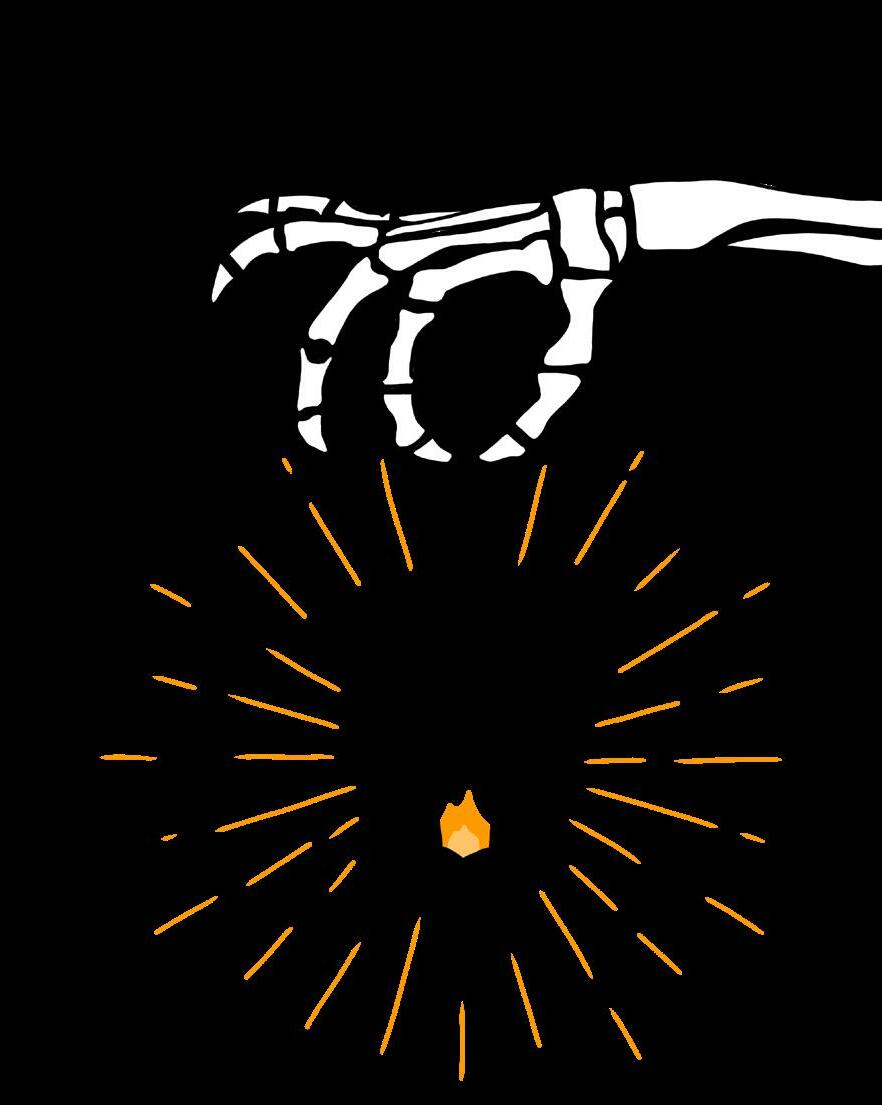

Many young children have tried to summon Bloody Mary by chanting her name three times in a dark bathroom; however, most have failed to see her actually appear. When she does appear in the mirror, though, she is said to show the summoner how they will meet their demise. She may also try to kill her summoner or simply stare at them from within the mirror. There is no clear origin story for this mirror ghost, but many speculate that her name may come from Queen “Bloody” Mary I of England who had many of her subjects killed. Japan has their own version of this spirit named Hanako-san, who can be summoned in a similar fashion but only in the girl’s restrooms at schools.

An urban legend that began circulating in the 1950s, The Hook tells the story of a teenage couple’s encounter with a crazed murderer and his hook hand. One summer night, the couple is on a date on Lovers’ Lane when they hear the radio report that a murderer has escaped the lo cal insane asylum. The murderer, nicknamed “The Hook Man,” is said to have a hook in the place of his right hand after losing the appendage in an accident. Frightened by the scratching sounds they had been hearing all night, the girl convinces her boyfriend to cut the date short and drive home. When the couple arrives home and exits

A lanky and ghostly white creature that stalks and kidnaps children, the Slender Man has become the Internet’s personal Halloween legend, created entirely by writers and fans online. The Slender Man was created during a Photoshop contest on the Something Awful Internet forum on June 10, 2009 by Eric Knudsen under the pseudonym “Vic tor Surge.” Slender Man quickly became viral, inspiring fanart, video games, and even movies. He is often seen wearing a black suit and tie in forests or abandoned areas, and being near the Slender Man is said to inflict delusions and paranoia. He stalks children before kidnapping them, suggested by a photo in which Slender Man can be spotted in the background of children playing at a park.
First published in 1820 and considered to be one of America’s first ghost stories, the “Legend of Sleepy Hollow” by Washington Irving is a short story about superstitious school teach er Ichabod Crane, who is often portrayed to be tall and lanky like a scarecrow. A newcomer to the New York village of Sleepy Hollow, Ichabod becomes infatuated with Katrina von Tassel, a young heiress who Dutchman Brom Bones also harbors an interest in. On his way home after Katrina rebuffs him at a party, Ichabod is chased by a headless man on horseback who throws a pumpkin at him and knocks him off his horse. Ichabod vanishes from town, never to be seen again. The Headless Horseman is often presumed to be Brom, who ended up marrying Katrina after Ichabod fled town. This story is believed to be inspired by a Hessian soldier who, during the Battle of White Plains in 1776, was decapitated by a cannonball.
Jeff the Killer first emerged in 2008 as a character from creepypasta. He, along with the Slender man, helped popularize the creepypasta genre. After a group of bullies bleached and burned 13-year-old Jeff’s face, his skin became paper white and leathery and his lips became cherry red. Finding his new appearance beautiful, Jeff burned off his eyelids so he could constantly admire his face and carved a smile into his face so he wouldn’t need to exert energy to smile. He is said to wake up his victims in the middle of the night, killing those who scream at the sight of his face and sparing those who go back to sleep silently.
Also known as the Weeping Woman, La Llorona is the tale of a woman who drowned her children in a river out of either grief or jealousy, depending on the version. As punishment, she was sen tenced to haunt Earth in search of her children’s souls in order to enter Heaven. Now doomed to wander the planet for eternity, she can be found crying by the river she drowned her children in. Sometimes, she may mistake children who stray far from their fam ilies for her own, and she is said to kidnap them. The story originated in Latin America and is common among Hispanic families, with most alleged sightings of La Llorona occurring in Southern California and New Mexico.
After two young couples from Point Pleasant, West Virginia reported a large gray crea ture with 10-foot wings in 1966, the story of the Mothman was born. Others soon began reporting similar sightings of a bird-like monster with glowing red eyes. The Mothman became introduced to a wider audience and popularized by John Keel’s The Mothman Prophecies (1975), which claimed that the Mothman had a connection to the Silver Bridge collapse in 1967. Since 2002, Point Pleasant has held an Annual Mothman Festival on the third weekend of September, originally hosted to draw tourists to the town. Food trucks, cosplays of the Mothman, and merchandise from local businesses are all featured in the festival.
“My favorite Halloween horror story is called The Ghost in the Hall. It’s a creepy story about a girl who loses her teddy bear in the new house she moved into, which turns out to be haunted. A special memory related to this story that comes to mind happened a few years ago. My older sister took my teddy bear and hid it in the closet, terrorizing me and fooling me into believing our house was haunted.”
— Zoya Adil, 9
“I think my favorite [Halloween legend] has to be The Monkey’s Paw. My fifth grade teacher Mr. Boyer was the first one to tell me it. Looking back [at it now, it] probably [was] not the best story to tell children, [but] ... this one was my favorite because of how perfectly creepy it is without being too absurd. Also, I couldn’t sleep the night after I heard it. So thanks, Mr. Boyer!”



— Lia Le-Nguyen, 10

“I remember there was this one story where a mother had a daughter that couldn’t speak, but the daughter wasn’t actually hers. The actual mom always tried to come and get the daughter but failed. It turned out that the fake mom’s daughter died by drowning so she kidnapped the fake daughter and cut off her tongue so she couldn’t speak.”

“The most mem orable part of all of the freshman class perfor mances was the dances that K-pop they used, all of which were su per trendy. There was one TikTok dance that origi nated from Fort nite, which really cracked me up. They did a spin move with their arms doing this cool movement.”
— Jay Gokani, 10












Blue paper stripes and balloons bound onto the railings posed a warm welcome as the crowd gathered at the amphitheater on Monday, October 3. Silhouettes of Metro Man and Megamind painted on the backdrops added to the mysterious atmosphere of Metro City, and the audience waited in anticipation for the first Homecoming perfor mance of the week.
After the live band began the show with Joe Hisaishi’s “Summer,” the fresh men began their skit with a classroom lecture. As the skit progressed with Megamind and Metro Man establishing an inauthentic friendship, the actors maintained well-choreographed hand gestures and impactful dialogue. Notably, Megamind’s insecure demeanor and Metro Man’s tirades on struggling with academics provided a balance of humor and suspense for the overall plot. The skit came to its resolution with Minion confessing his schemes of destroying Metro Man and Megamind’s friendship, demonstrating the importance of establishing relationships not through instigation but through benevolence and unity.
To start off their airbands, the freshmen performed a unique fusion between the lyrical airband and the fight scene. Following the lyrical dancers’ gracefully executed routines, the fight scene performers engaged in ag gressive hand-to-hand combat, invoking excitement as the crowd eagerly awaited the fighters’ next moves. The hip-hop airband also took the stage dressed in bright blue t-shirts and performed a series of intriguing footwork and energetic arm swings.
To match the high energy of the hip-hop airband, the singing airband harmo nized to popular songs such as Doja Cat’s “Say So” and Dua Lipa’s “Don’t Start Now.” Despite initially facing audio issues, the trio car ried on with their performance, encouraged by supportive claps from the audience.

Afterwards, the K-pop airband recreated iconic dance moves from NAYEON’s “POP!” and powerful choreography from BLACKPINK’s “Kill This Love.” As “SNEAK ERS” by ITZY blasted across the amphitheater, the crowd burst into screams and sang along as performers passionately danced to the song’s lively beats.
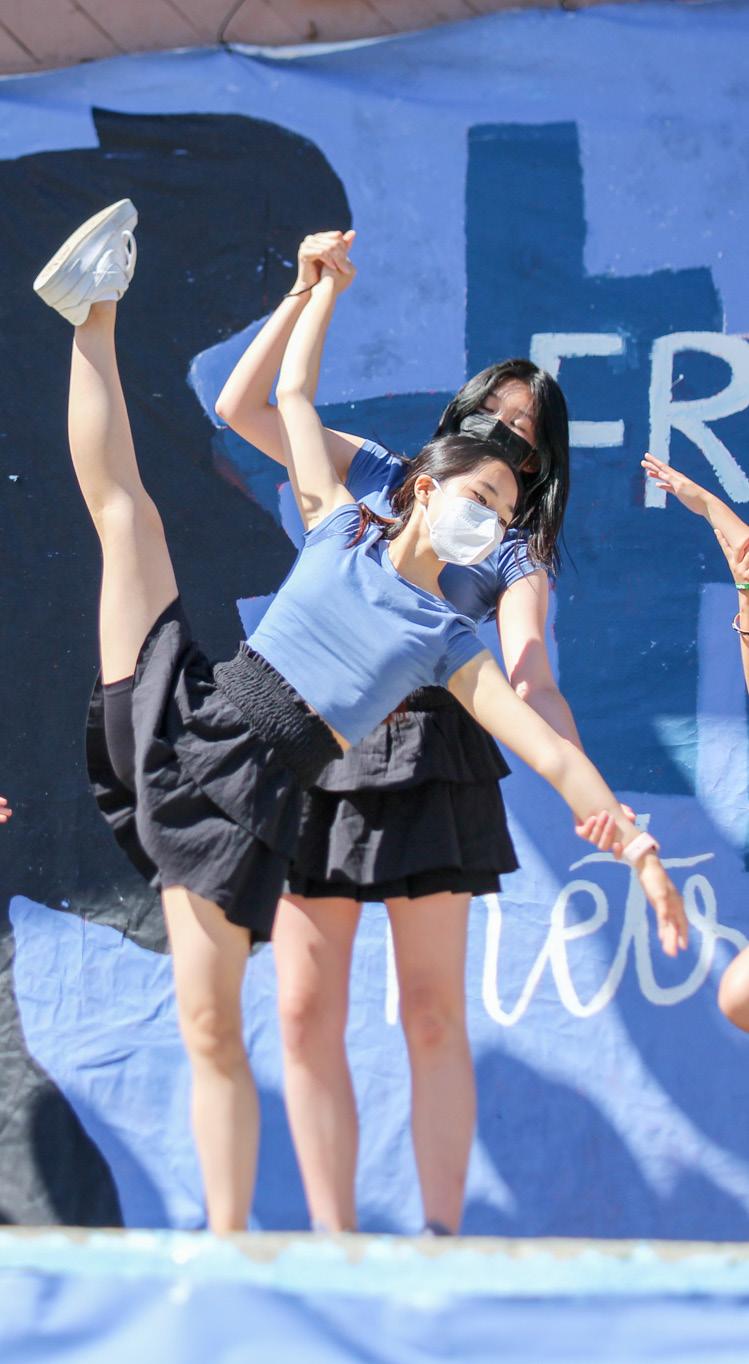
In the class’s final airband performance, Bollywood dancers dazzled in gold-accented blue pants packed the stage as they performed to “INDUSTRY BABY (feat. Jack Harlow)” by Lil Nas X and Jack Harlow and “Naatu Naatu (From “Rrr”)” by Rahul Sipligunj, Kala Bhairava, and M. M. Keeravani with choreography featuring multiple formation changes and classical Bol lywood moves. Despite the large number of dancers that took the stage, the airband stayed synchronized throughout their entire performance. The crowd erupt ed into cheers as dancers formed a hand bridge that they proceeded to dash through, ending the performance on a high note. All performers stepped on the stage after the final airband, chanting “We don’t miss, 26.” Although new to the concept of Homecoming, the freshmen demonstrated their high spir its through fine choreog raphy and compelling plotlines, placing fourth in the final standings.
“Especially for their first homecoming, the fresh man class had incredible organization and cohe sion. From the deco to the skit to each individ ual airband, [the] Class of 2026 proved to be incredibly adaptable. For instance, even when the microphones didn’t work for the singing airband, each member pulled their own weight and fin ished the performance, which really impressed me.” — Selina Kao, 12
“[K-pop air band] was ad dicting to watch and their finale was a satisfying end to the performance.” — Jeffrey Li, 9
“Though nearly ev erything in the fresh man performance was stellar, the main thing that really blew me away was the stunning decorations, from the balloons to the posters.” — Karthik Sista, 9
“I was impressed by their perfor mances; everyone was so energet ic and excited about their Home coming, even though it’s their first one.” — Siran Wang, 11


“The whole thing was pretty good though. The K-pop per formances were amaz ing. I really liked the danc es.” — Aryav Das, 9

Lines of yellow and white balloons streamed towards a pic turesque red and yellow sunrise framing the large, grinning Mufasa from the Lion King


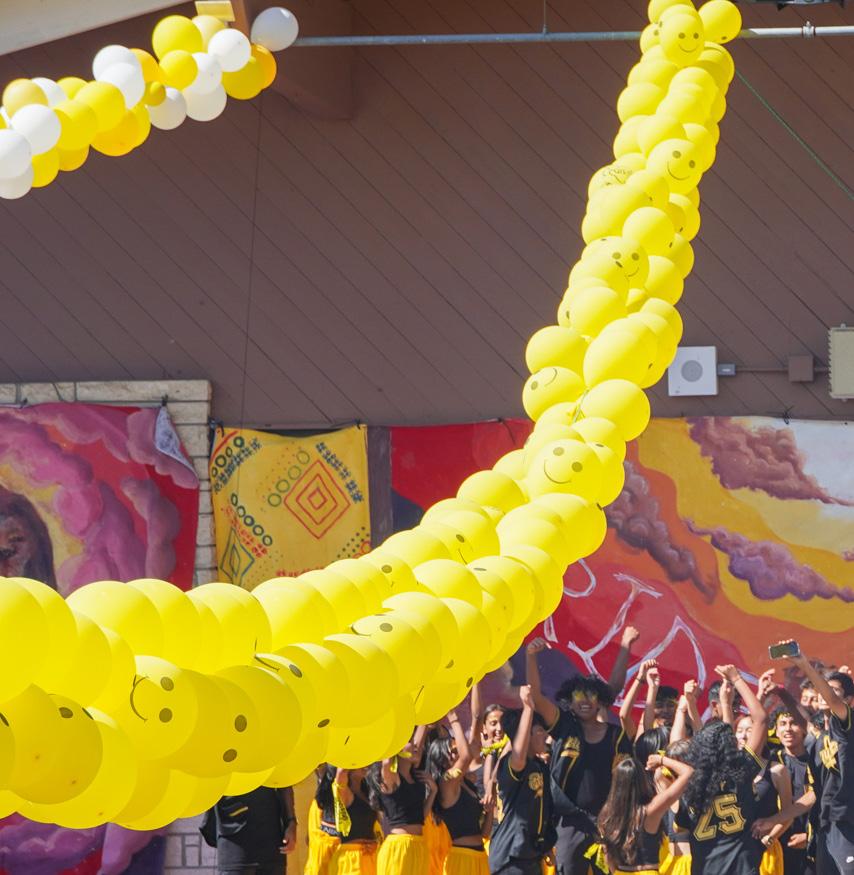
A live band clad in yellow bucket hats welcomed students to the Class of 2025’s Homecoming per formance.

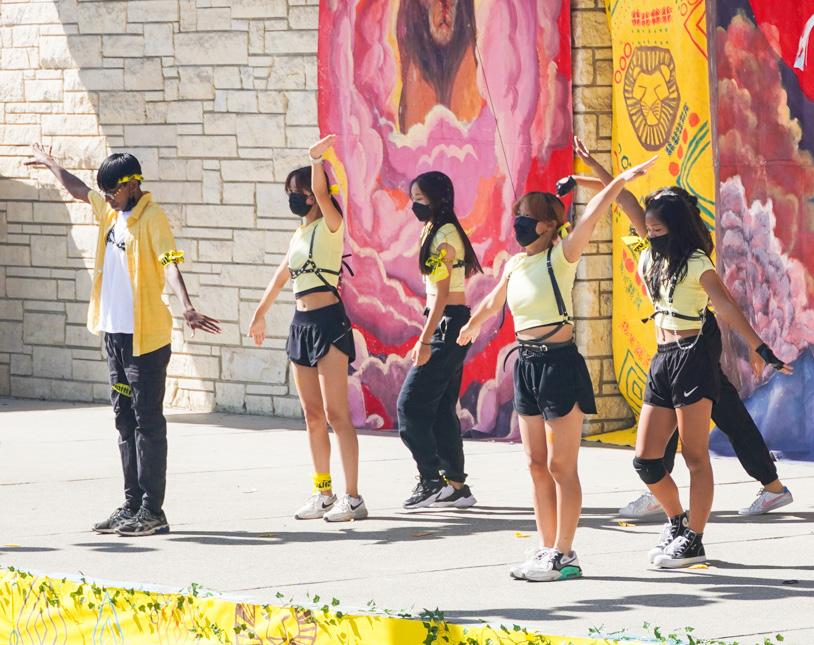
Sophomore Homecoming kicked off with a medley of hit songs, including “We Are Never Getting Back Together” by Taylor Swift and “Welcome To The Jungle” by Guns N’ Roses. The crowd of musicians departed as Mufasa and his son, Simba took to the stage, arguing about Simba’s music taste and sense of duty. Touching on themes of unity contrasted with Mufasa’s obsession with the monarchy, the skit was a hit among students. Adding an exciting spin to the original Lion King storyline, Simba’s Swiftie status and hilariously offbeat Taylor Swift references allowed for a satisfyingly smooth transition into the singing airband.
The singers’ pitch-perfect performance of nostalgic tunes such as “You Belong With Me” and “Enchanted” by Taylor Swift stirred students to enthusiastically clap and sing along. A mashup of “Burn” from the musical Hamilton and “traitor” by Olivia Rodrigo that followed filled the amphi theater with heartfelt emotional vibrancy in between the joyful performances, reflecting Simba’s grief in the skit that followed from Mufasa’s death as he fought with his brother, Scar.
“I think their C-pop airband was the best. It was something that was really unique and never done be fore, I’m pretty sure. They were very in sync and I especially like the part where they did the wave with the fans, because it just looked so aesthetical ly pleasing and cool.”







 — Etta Sou, 12
— Etta Sou, 12
Following the singers, the Bharatanatyam airband arrived onstage; their playful expressions and intricate handwork captivated the crowd. Their calmly paced choreography segued smooth ly into the C-pop airband, as dancers twirled their embroidered fans in unison, alternating be tween refreshingly tranquil jumps and lifts and controlled body isolations. The light hearted calm energy segued into Simba’s idyllic time growing up in the jungle Pumbaa and Timon after fleeing from the tribe. The elaborate dance formations emphasized the danc ers’ elegance, showcasing their months of practice.
In stimulating contrast with the gen tle C-pop routine, the hip-hop airband entertained the audience with their up beat bursts of movement, including a brisk Michael Jackson moonwalk. The K-pop airband carried hip-hop’s energy and elevated it to instantly draw cheers from the crowd, with elaborate choreog raphies to songs such as “O.O” by NMIXX and “Easy” by Stray Kids. Outfit changes between songs brought a fresh energy to each dance, building the crowd’s anticipation throughout the performance. The excitement added to Simba and his childhood friend, Nala’s reunion in the jungle that followed. Continuing with references to unity, the skit traced Simba’s return to the tribe to save his old friends from Scar’s tyranny. The anticipation led into the Bollywood airband, which innovatively incorporated the “Kala Chasma” TikTok trend into their lively routine, with the dancers boasting yellow-rimmed sun glasses with “CO 25” painted across the lenses.
To capture the final battle between Simba and Scar, the fight scene airband launched into a fast-paced invigorating sequence. Featuring aerials, mid-air splits, and extravagant acrobatics, the sophomores engaged in a series of intense fights, living up to the battle between the lions and the coyotes in the orig
Winning second place overall, the sopho mores raised the bar with this year’s Homecoming. Their eye-catching costumes and props, humorous skit, and energetic choreography cap tured the lively spirit of the




favorite part of their performance was the Michael Jack son piece in Hip-Hop air band. It was so cool to see the Hip-Hop leaders incor porate Michael Jackson into an airband perfor mance. The guy in the center was insane, the outfits and dance were perfect, espeically with that moonwalk!"
— Angelina Ching, 11










 By Chahak Gupta & Annie Xu Staf Writers
By Chahak Gupta & Annie Xu Staf Writers























 By Sarah Hu & Elaheh Khazi
By Sarah Hu & Elaheh Khazi
“I think the junior deco[rations] [have] really improved and [were] super cool this year. There were more pieces this year and a lot more details, like the metallic stickers and the glow of the lightsaber on the other characters in the panel.” — Alyssa Chen,
With the amphitheater decked out in Star Wars decorations and print-like backdrops, the Class of 2024 started their Homecoming perfor mance with much zeal and excitement during lunch on Wednesday, October 5. Silver ribbons wrapped around the railways and fences leading into the area, and black and silver balloons hung in rows, decorating the amphitheater.

The juniors were ready to show off their class spirit and hard work.
Kicking off the performance, the live band had a quick routine playing to “The Imperial March (Darth Vader’s Theme)” from Star Wars and “Fly Me To The Moon” by Frank Sinatra as students settled on the grassy field getting ready to watch the juniors. Jumping up and down, the singing airband came on stage next with their microphones and instruments, ready to sing to popular songs such as Harry Styles’ “As It Was,” Joji’s “Glimpse of Us,” Vanessa Carlton’s “A Thou sand Miles,” and Sam Smith’s “Love Me More.” The singers harmonized, and the audience happily sang along to their favorite tunes.
Once the singing airband finished, the Star Wars-themed skit began. Characters dressed as Rey representing the freshmen, C-3PO representing the sopho mores, Kylo Ren representing the juniors, and Darth Sidious representing the seniors, were key figures in the play. The skit quickly established a complex plotline with the senior, Darth Sidious as the antagonist. The play included humorous jokes and dances, such as the default Fortnite dance, as the characters united to defeat the evil Darth Sidious, which the audience thoroughly enjoyed as everyone cheered them on. The characters’ costumes, capes, and fights with lightsabers enhanced the immersion of the skit. Afterwards, the hip-hop airband enthusiastically danced to Doja Cat’s “Woman” and Kanye West and Lupe Fiasco’s “Touch The Sky,” while executing clean and syncopated moves.
The Jazz Funk airband dancers neatly combined ballet moves with jazz steps as they danced to Bruno Mars’ “24K Magic” and other songs. The performers then seamlessly transitioned into the fight scene, keeping the audience on their toes. K-pop airband then delivered a well-rehearsed and synchro nized performance. Their choice of music from popular groups such as TWICE, BLACKPINK, and SEVENTEEN had the audience cheering in support.
Dressed in formal and matching attire, the ballroom dancers created different artistic formations and patterns. When ballroom finished, the crowd’s attention shifted to the Bollywood airband. They entered the amphitheater jumping and dancing to loud music. Dancers incorporated flips and tricks with traditional moves into their choreography and surprised the audience with a quick costume change into skirts.
Last to enter the stage was fight scene airband as the backstage eagerly chanted for them. With performers flipping through the air and others ducking to the ground, the quick combat was was reminiscent of a realistic lightsaber battle and had the audience on their feet.
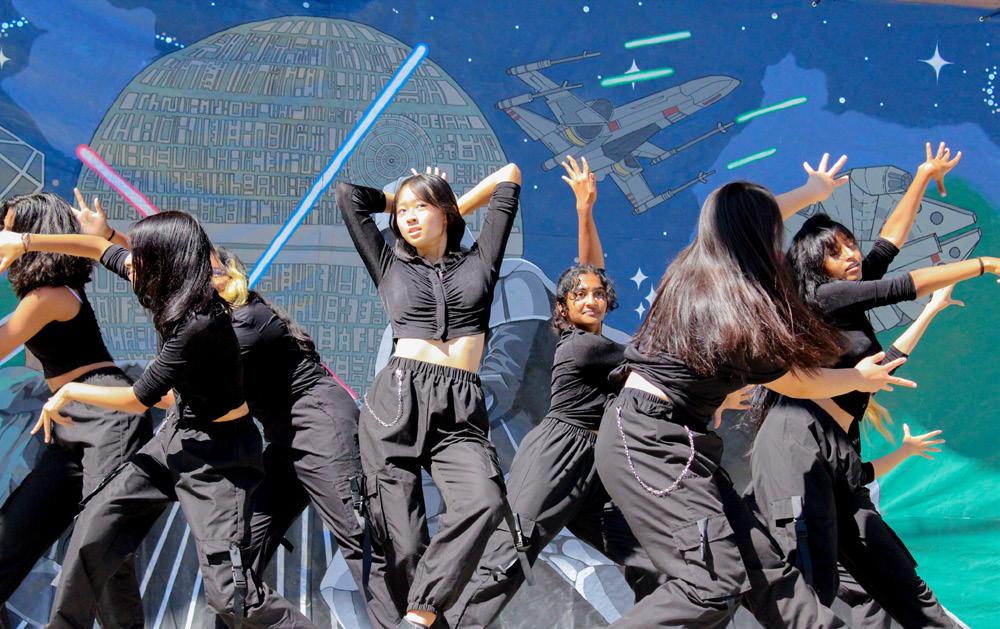
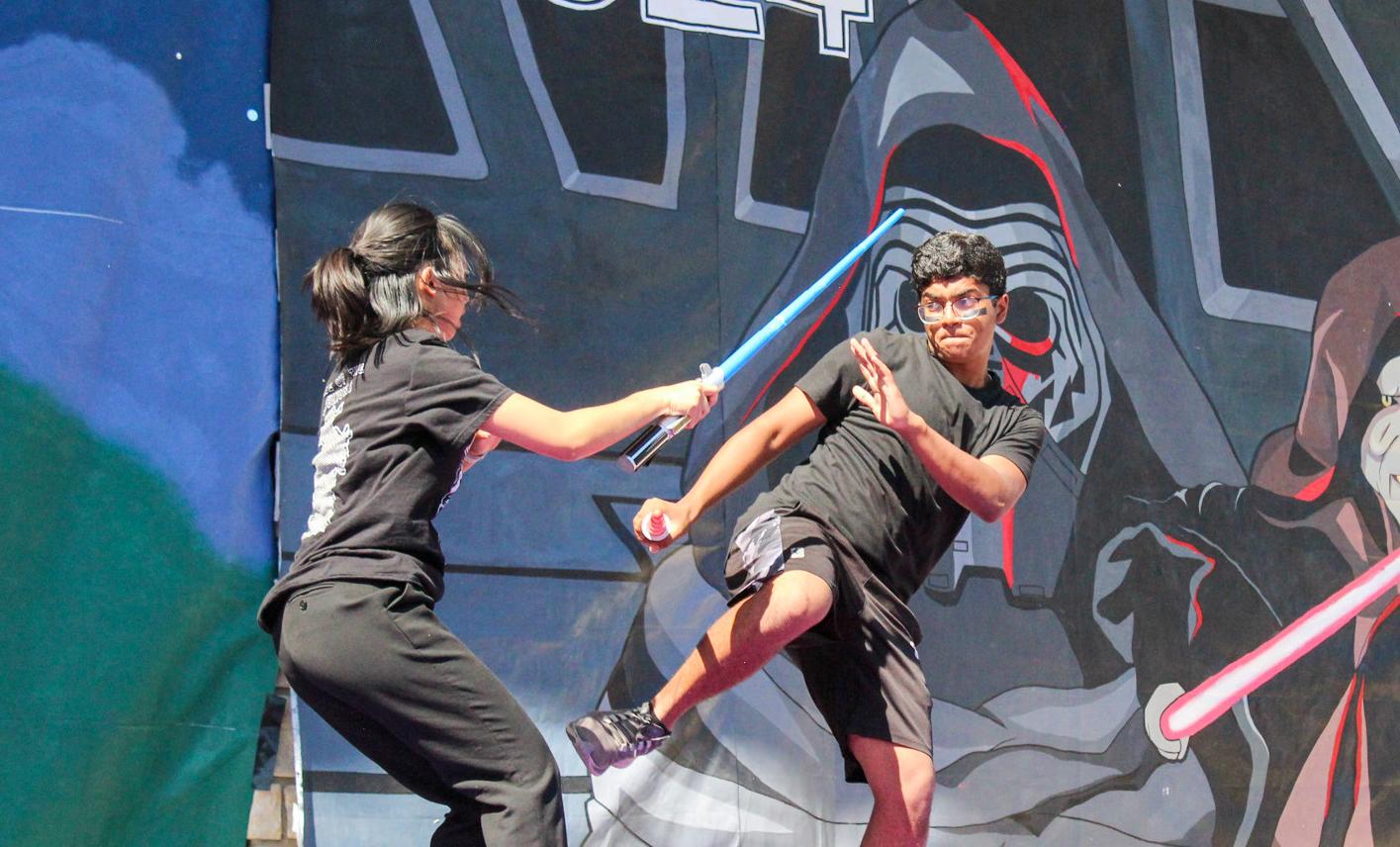
Throughout the entire lunchtime performance, the perform ers delivered stunning, well-choreographed dances and showed their junior class spirit. Ultimately, their deco, skit, and airbands all coordinated to tell one story, allowing them to place third overall and create a memory the MSJ students will not forget.

“The most memo rable part ... was definitely the depth of the performances, which ended up being very impres sive. The dances were well thought out, and I liked the execution.” — Angelina Chen, 10

“The Bollywood airband was definitely the most memora ble part of the performance. The atmosphere in the crowd was electric as soon as they entered onto the stage.”

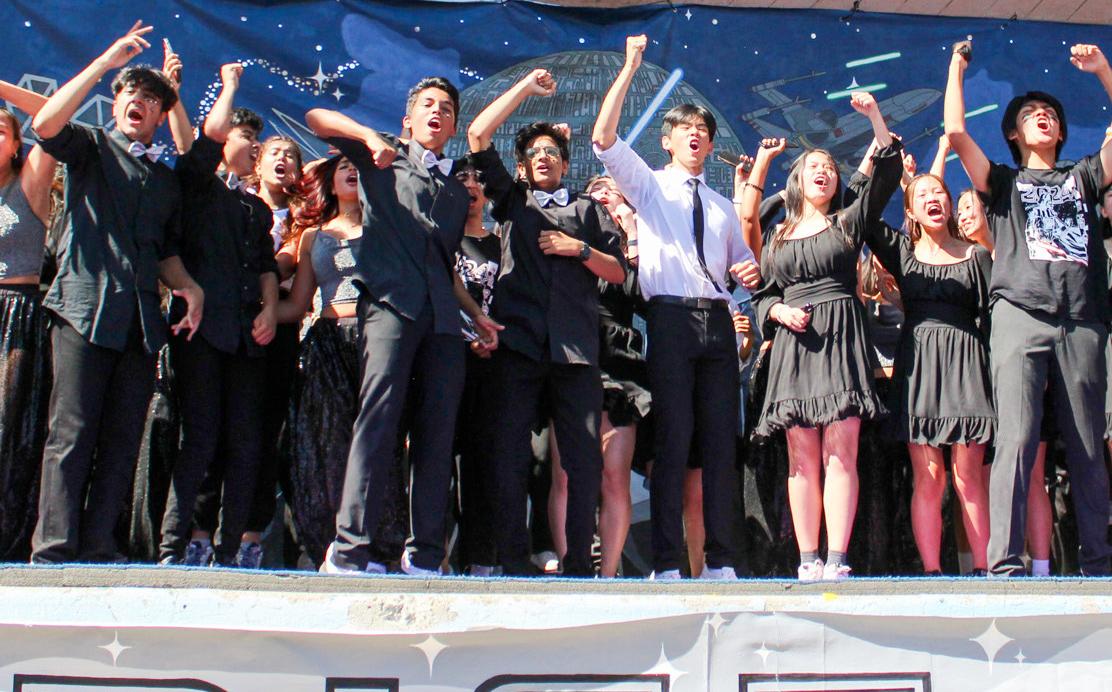

Mehul Maurya,

“The juniors aced the fight scene in my opinion. From the choreography to overall audience reaction, everything exceeded my expectations. Their fight scene also consisted of lightsabers, which was a really cool factor.”
Li,






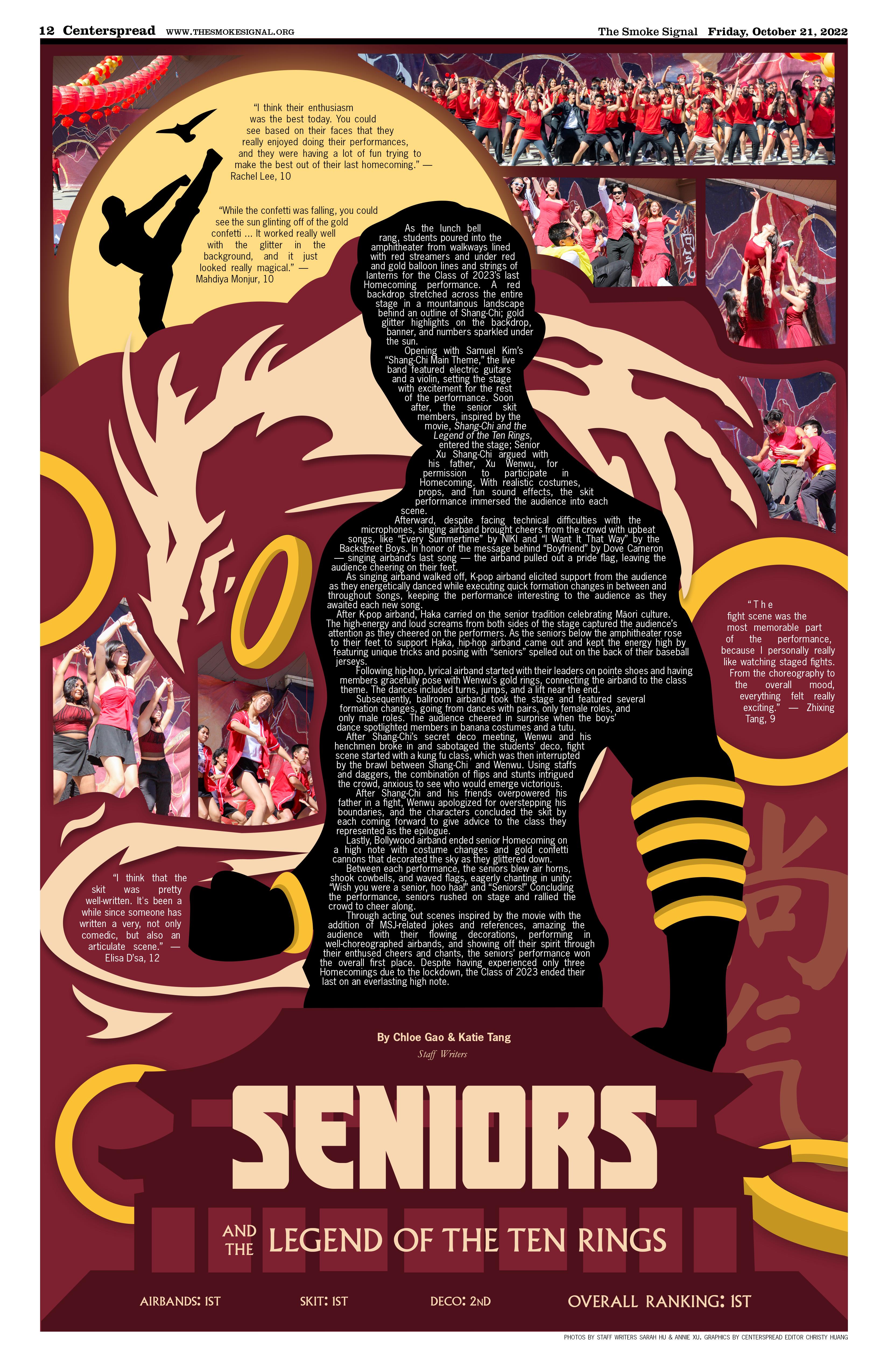
Scott “Kid Cudi” Mescudi’s latest release, Entergalactic, is a culmina tion of his creative experience into an original and innovative project. For years, Cudi has monotonously modeled albums after his well-re ceived debut, Man On e Moon: e End Of Day. His last album, Man On e Moon III: e Chosen, was similarly empty and uninspired. Since then, Cudi has attempted to diversify his portfolio, entering the acting scene and making his directo rial debut. Both an album and ani mated feature, Entergalactic breathes new life into Cudi’s library.
e animated Net ix special follows the typical formula of any rom-com. Upon recently ending a relationship with his ex-girlfriend, Carmen (Laura Harrier), Jabari (Kid Cudi) meets love interest Meadow (Jessica Williams), a photographer with similar interests in music and art. Flashbacks to Jabari’s time with Carmen are scattered throughout the lm as he attempts to learn from previous mistakes and ght o his anxiety. While navigating this new relationship, Jabari is also tasked with revitalizing a comic-book store with a series based on his character, Mr. Rager.
With Entergalactic, the tone is more lighthearted compared to Cu di’s previous albums about escaping death and depression, allowing for a more cohesive tracklist in addi tion to sentimental lyrics. On “Do What I Want,” Jabari looks forward to a clean slate. e synth typically associated with Cudi’s music com plements his poised attitude in this song. As the album progresses, the

under the radar
Kwon So-hee, better known as SAAY, is a South Korean R&B sing er-songwriter, composer, producer, and model under Universal Music Korea. According to Fandom, SAAY says her stage name means “Say some thing to the world through music,” mirroring her passion for music and her hopes of impacting the world through it.
SAAY is a former member of EvoL, a fve-member girl group that unofcially disbanded in August 2015. She went on to make her solo debut on July 28, 2017 with the single “CIRCLE.” Since then, SAAY has released a variety of projects and has appeared in nine works of other art ists, including famed rapper Snoop Dogg’s “Alright (Redman & Meth od Man feat. Nefertitti Avani).”
SAAY has also composed, written, and produced for popular Kore an artists TWICE, BAEKHYUN, ex-SUPER JUNIOR-M member Henry, and aespa. Along with her collaborative projects, SAAY’s solo music is available to stream on Spo tify, Apple Music, YouTube Music, and other major music streaming platforms.
Taking a look back, SAAY says the role models and infuences who inspired her to pursue music are old-school R&B artists from the 1970-90s, such as Michael Jackson and Destiny’s Child. As she writes lyrics, however, she considers every moment in her life to be a potential source of music, according to the Ko rea Times
In the future, SAAY wants to continue being herself and stay close to her identity as she releases more music and dives deeper into the com petitive industry. “The only thing I want to be in the future is me,” she said in an interview with the Korea Times.
tone shifts to match the state of Ja bari’s relationship. For example, on the slower-paced “In Love,” Cudi sings, “Flyin’ with me through the clouds, we go sky-high / Take my hand and close your eyes and take the ride, ride.”
Over its 92-minute runtime, the movie’s most captivating element is the visuals. Simply put, the feature is beautiful with a vibrant, psyche delic art style, particularly in the dream sequences where Cudi’s anx ieties are personi ed as Mr. Rag er. When paired with the album’s tracks, the lm perfectly captures the atmosphere of love in New York City. Similarly, the feature excels at creating genuine character interac tions. For example, Jabari’s friends, voiced by actors Keith David and Timothée Chalamet, are all lively and entertaining despite their lim ited screen time. However, the lack
of real nuance in the plot makes for a predictable watch. By the end of Entergalactic, everything seems to work out perfectly. Jabari secures his dream job and a healthy relationship with his girlfriend. His few struggles regarding his comic book series are short-lived, leaving the lm feeling one-dimensional. Although the plot is not groundbreaking by any means, the special succeeds at depicting the overarching theme of love visually and audibly.
In light of Cudi’s previous works lacking originality, his newest project nally feels fresh. Beyond the dual release, Entergalactic explores topics of love in a natural and artistic way. Despite its predictability, Entergalac tic is a treat, but more importantly, a creative breakthrough for Cudi that opens new doors for the artist.
Grade: B+

On October 7, punk-rock art ist Willow Smith, known as WIL LOW, returned a year after her last release with her fth album <COP INGMECHANISM>, a collection of electric and powerfully dynamic songs that perfectly embody the feelings of struggle that comes with breakups. While embracing a new style of heavier metal-rock sounds, WILLOW opens up about her expe riences with heartbreak, emphasiz ing the cathartic journey from dev astation to self-acceptance. Despite the tracks being rather repetitive, WILLOW successfully delivers her message on relationships while step ping out of her comfort zone.
As the album title suggests, <COPINGMECHANISM> represents how WILLOW dealt with teenage angst and the torturous thought processes that come with heartbreak. At the beginning of the lead single “<maybe> it’s my fault,” WILLOW repeatedly sings, “I don’t know / How I can forgive you,” clearly portraying the feelings right after a devastating breakup. As she frantically recalls the details of her breakup, she looks for ways to ease the pain. She targets all the blame onto the other person to cope as she screams the line, “It’s your fault.”
However, as the album con tinues, these lyrics evolve from negligence to self-accountability. WILLOW shows responsibility for the mistakes she made throughout her relationship: in the title track “<Coping Mechanism>,” she sings, “I’ve wasted so much time / Hating myself for trying / Accepting thatthis fate is our demise.” Rather than hiding from the shame of relentlessly ghting for a relationship that would never work out, she accepts that sheneeds to move on. WILLOW in spires listeners to be all right with accepting defeat, and to learn from these experiences. WILLOW con tinues to re ect on her own short comings, displaying growth with
each song. “curious/furious” deliv ers one last message to wrap up the message of the album: “Getting overit now and I / Never wear a frown / Because life doesn’t choose either side / Win or lose, right or wrong / It’s a battle that’s all in your mind.” She reminds listeners that with every setback comes a learning opportuni ty, and it is up to the person to stay optimistic and persevere.

<COPINGMECHANISM> sheds new light on WILLOW’s musical style. Although known for her punkrock, WILLOW uses <COPING MECHANISM> to step out of her comfort zone and explore hard rock and metal rock, following in the footsteps of her in uences Radio head, Deftones, and Lamb of God. While this genre of music is a new breakthrough for the 21-year-old artist, the tracks are all on the safe side, lacking components to make the al bum stand out. Many tracks such as “curious/furious” and “WHY?” have repeating themes, failing to expand past the basic ideas of a failed rela tionship. While the songs all have enjoyable elements and emotive lyrics, the lack of contrast makes the songs easily Nonetheless,forgettable.
<COPINGMECH ANISM> is not only vibrant and bold but also sends out an important message that people all around theworld can relate to. As WILLOW ghts her demons, her album shows that she takes this opportunity to learn and change for the better, and inspire others to do the same.
: B+
Intriguing yet minimalistic, di rector Olivia Wilde’s second movie Don’t Worry Darling is a stereotypi cal throwback to the 1950s, where patriarchy and suburban mid-cen tury homes dominate. is psycho logical thriller features an under developed plot and stale thematic interpretations.

Don’t Worry Darling starts o with an idyllic setting, but quick ly deteriorates — Alice Chambers (Florence Pugh) and Jack Chambers (Harry Styles) live in a glittering fairytale set in the town of Victory. It quickly becomes apparent that something is not right, and the lm leaves the audience anticipating a twist. e lm violates the sole rule of a mystery; the audience’s predic tions leave no room for suspense. Al ice’s role as a housewife collides with her internal confusion that some thing is out of place. From Alice wrapping her head in plastic wrap
to having vivid hallucinations and ashbacks, the power of the lm’s third act is overshadowed by its in herent shock value.


While this lm’s plot is conten tious, Pugh’s performance as Alice is undeniably stellar. With the lm shaped from her perspective, Alice’s undoing of her Edenic lifestyle is particularly evident to the audi ence. Pugh excels at the portrayal of tapping into Alice’s worst impulses along with her best traits, bringing emotion and richness to her scenes. rough her dynamic expressions, Alice’s internal con ict seeps into the lm, coloring her interactions. Her co-stars also display moments of brilliance: Styles successfully con vinces viewers to trust the doe-eyed husband Jack, Olivia Wilde voices many of Alice’s inner thoughts as her best friend Bunny, and KiKi Layne adds a true element of fright to the lm as the frantic housewife Margaret. ough these characters revolve around Pugh’s world, Chris Pine alone opposes her as Victory’s
revered leader Frank. By escalat ing their combative relationship through conversations at the dinner table, Pine introduces a compelling antagonist, an e ect accentuated by di erent songs and visuals.
Many of the lm’s most strik ing scenes are brought to life by the extraordinary cinematography and soundtrack. With Don’t Worry Dar ling centering on the crumbling of Alice’s utopia, the cinematic focus on her hallucinations creates dis sonance. Alice is seen racing across an endless desert and being crushed by walls, unable to distinguish her dreams from reality. In turn, the score becomes increasingly ominous, with breathy vocals playing in the background. is e ect is exacer bated by the various visual motifs, like the perfect circle that Alice re peatedly sees after she becomes lost in thought.
Cinematography aside, the lm’s central theme of femininity is bla tantly juxtaposed with the su ocat ing patriarchy of the 1950s. In this
fragile, arti cial society, all subjects related to femininity are distorted: from somber all-female dance stu dios that convey uniformity to the town’s characterization of Alice as hysterical after the death of her friend, femininity and madness be come intrinsically linked. However, the idea that women are reduced to nothing but the sum of their parts is nothing new, and a lack of inter sectionality propels the lm closer to a surface-level display of white feminism than introducing a new perspective.
Two hours of mind-whirling scenes and a few gripping perfor mances later, the lm ends on a low note. Its cheap exploitation of shock value and shallow explora tion of themes cannot be reconciled with its cinematography or acting, and in the end, Don’t Worry Dar ling remains true to its title as it is neither of concern nor particularly worthy of critical acclaim.
Grade: B- IMDB COM
On June 21, a new comfort shop for fel low book-lovers opened in downtown Fre mont at 3768 Capitol Ave. Suite F: Banter Bookshop, and it brings back the experi ence of physically going to a bookstore, pe rusing sections, and sitting in a nook while embarking on a new adventure.



Banter Bookshop had been a dream proj ect of founder Amy H. Davis for a very long time. Davis had been looking for properties and eyeballing areas that would be suitable for a bookshop, but the pandemic halted those plans. Despite these initial setbacks, however, the team was able to settle on a property and host the ribbon cutting for the opening of their bookshop in June within a span of six months.
Walking into Banter Bookshop invites an instant feeling of comfort. Aside from the regular characteristics of a bookstore, Ban ter Bookshop has special touches such as cozy reading nooks and books for everyone that make the experi

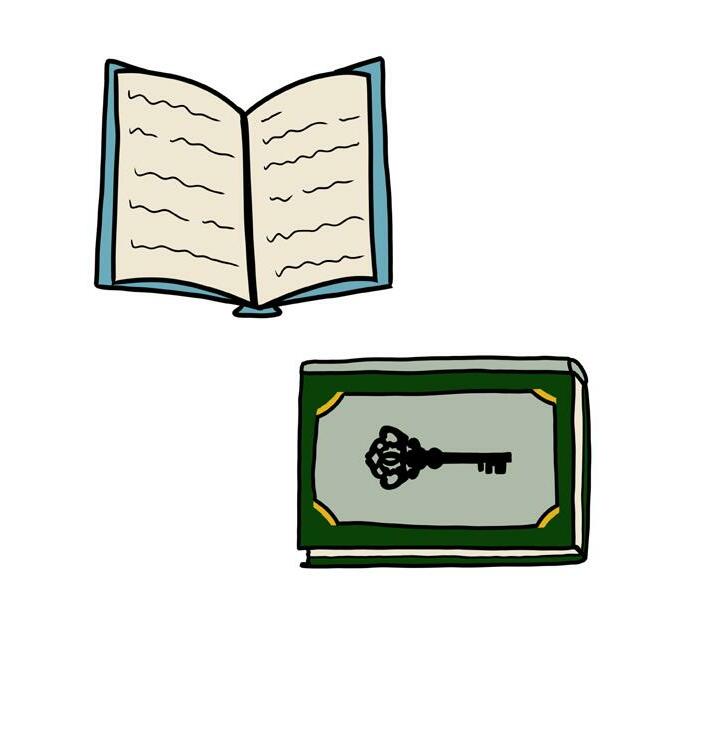
ence that much more enjoyable. Beginning at the back of the shop, there is a section for games and puzzles, which are a crowd favorite. Right ahead are books for middle-grade readers accompanied by subsections such as FUSD core literature and new releases. Hav ing an FUSD section is a unique perk because it provides a curated collec tion for inquiring parents to browse books their children may need for school.
One of the most well-liked parts of the bookshop is the kids corner where weekly story times are held for young children. During these story times, the staff usually read to the children, but on special occa sionsometime, the authors of the books come to read their own stories, like local author and illustrator Joy Steuerwald did on October 8. e store also hosts events outside of story times in cluding regular author visits, where authors are invited to come and discuss their books.
is allows a wide variety of authors to use the bookstore as a platform to share their craft to an interested audi ence. For example, author and journalist Tyler Bridges will be coming in during November to talk about his
latest book, Five Laterals and a Trombone. Another special corner of the bookstore are a Latinx Heritage Month section and an LGBTQ+ History Month section which is also on dis play. ese displays hold appropriate books for the topic, keeping cus tomers informed while spreading awareness.
In addition, one ven ture that the bookstore supports is the Prisoner Lit erature Project. To support the cause, customers can buy books that the store will later donate to prisoners.
Although the bookstore has just recently opened, it has already sparked joy within the community. “It’s nice to have this kind of outlet for families because in the past, there hasn’t been another bookstore other than Half Price Books, but that’s not the same thing,” store employee Mallika Saoji said. Half Price Books often caters to a larg er variety of books and mostly pre-owned books, while Banter Bookshop aims to fill in the gap as a cozy bookstore. Due to the fact that Half Price Books is just right around the corner, both bookstores tagteam and send customers to each other’s stores based on what books are available.
As book trends fluctuate, the bookstore’s selection does as well, with customers re questing specific books that are in demand. For example, the store did not originally have a romance section, but one was cre

ated by the request of many customers. An example of these fluctuations include how some of the most popular books and au thors that have been in circulation in the store since its opening have been e Seven Husbands of Evelyn Hugo by Taylor Jenkins Reid and novels written by Colleen Hoover and Jennette McCurdy. “It correlates with internet trends because Colleen Hoover was really popular on TikTok as well,” Saoji said.
A development that Da vis hopes to introduce in the future to the book store is a section for lo cal authors. Although it isn’t quite ready yet, this is something that would give local authors a chance to display their newly published books and gain a wider reach. It would also allow the bookstore to showcase a selection of writers representative of the area, which could help lesser known, local writers make a name for themselves.
Banter Bookshop has succeeded in cre ating a safe space where book-lovers can experience the joys of an in-person book store. e unique perks of the store such as holiday displays paired with exciting events like story times and author events are just small a glimpse into what the store has yet to offer.
Netflix’s Dahmer - Monster: e Jeffrey Dahmer Story released on September 21 to both critical acclaim and controversy. In un flinching detail, the limited series portrays the grisly murders and other violent exploits of notorious American serial killer Jeffrey Dahmer, portrayed by Evan Peters. On social media platforms, people discuss the show’s violent scenes, and some individuals don’t seem to be affected by the gore at all. Desensi tization towards true crime has risen over the years, thanks to overexposure to media forms such as podcasts, movies, and TV shows like e Jeffrey Dahmer Story , leading to blatantly inappropriate public responses, such as jok ing about the victims and sympathizing with Dahmer. According to a survey by market re search company YouGov, one in three Ameri cans consume true crime content at least once a week. is type of mass audience appeal is why there is an increase of shows like e Jef frey Dahmer Story — but ethics are often lost in the favor of profit and pleasing fans.
After the release of e Jeffrey Dahmer Story , many individuals, most notably the families of the victims, have expressed discontent toward the show as it brings up incredibly traumatic past experiences that many of them are still recovering from. Moreover, the directors not only created the show without their consent or prior knowledge, but they also did not give any of the profits to affected families or or ganizations that could help people in similar circumstances — profits that were made at the expense of marketing their stories and trau ma. is led to incredibly devastating realiza tions as victims saw themselves in the show, played by actor look-alikes. “If I didn’t know any better, I would’ve thought it was me ... at’s why it felt like reliving it all over again. It brought back all the same emotions,” Rita
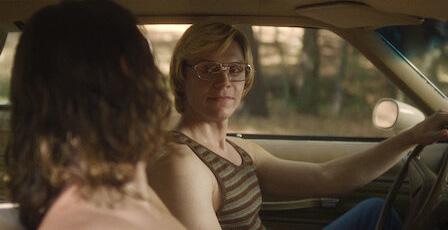
With the constant release of unnaturally cruel true crime media, audience members are becoming incredibly vulnerable to the desensitization of the horrors of the content and its impact on real people. For example, segments of many true crime podcasts could easily be mistaken for candid discussions of pop culture from how cheery and irreverent they are. True Crime Daily e Podcast re leases this type of lighthearted content, once discussing a mother who was killed by her husband with lines like, “I mean there was blood everywhere, it was crazy,” laughing the situation off is type of rhetoric takes away from horrid events victims have experienced.
Due to such detached methods of describ ing atrocious situations, it becomes easy for individuals to stop seeing true crime as retell ings of horrific events but instead just another form of gritty entertainment, similar to that of a horror movie. Viewers have even talk ed about e Jeffrey Dahmer Story not being “violent enough” for true crime, leading to a TikTok trend of searching up the real po laroids of Dahmer’s victims for shock value.
Indeed, there have been concerning re


sponses across social media platforms. Tik Tok and Twitter have been flooded by view ers showing themselves wearing fan-made merchandise and creating fan content for the depicted serial killer, a trend that can be seen throughout other true crime fanspa ces. In fact, there has been an auction for Dahmer’s actual glasses, which ended up selling for $150,000, showing that there is still some form of idolization for Dahmer among viewers.
Also, this inappropriate reception to true crime media is not a new phenomenon. An other Netflix production, Extremely Wick ed, Shockingly Evil and Vile , was released in 2019, where Zac Efron played notorious serial killer Ted Bundy, and many individu als were quick to romanticize Bundy due to Efron’s appeal. In the same manner, videos talking about how “attractive” Peters is as Dahmer have gone viral. e good looks of the actors are used as a way to glorify mur derers, and fans are failing to consider the real repercussions these grotesque acts of vi olence had on the victims.
Despite blatant unempathetic and im proper reactions, a common defense of true crime is that it’s a way for fans to learn how
to protect themselves in similar situations. If fans know what works and what saves peo ple, they can use lived experiences of victims to help themselves if they are ever in danger. However, people fail to realize that most true crime content has been streamlined and cherry-picked: as an inherently profitable form of entertainment, true crime media predictably only explore events the public would consider interesting, making them bi ased sources of information regarding safe ty tips. Instead of getting caught up in this odd reverence for Dahmer, it makes more sense to think about those affected by his gruesome actions; Dahmer targeted men of color, inflicting damage to their corpses and sometimes even consuming them. Repulsive criminal activity deserves no idolization — true crime producers need to understand that when depicting these illicit o ffenses for the general public.
is is not to say true crime media doesn’t have any benefits. A large number of pro ductions primarily center on the actions of the police or the judicial system, highlight ing their downfalls and creating more aware ness for the public to be able to hold these institutions accountable. However, mindful media must be produced — if it is created without the consent of the families like e Jeffrey Dahmer Story had been, it should not have been made at all.
People must consume content respect fully, meaning viewers must remember that the victims are real individuals and their stories should be for spreading awareness, not just entertainment. e release of e Jeffrey Dahmer Story in particular has stirred many debates, but the underlying message is clear — true crime media, and its hardcore followers, often cross too many lines. If con tent is to be created, the production must obtain consent from the victims’ loved ones, and public response needs to be respectful and empathetic.
Sophomore Michelle Woo was introduced to golf at just eight years old when her dad would take her to the golf range to play. What started out as a hobby with her family soon grew into one of Woo’s passions. Since then, she has attended numerous competitions and already accumulated titles on regional, state, and national levels. In June, Woo competed at the prestigious American Junior Golf Associ ation’s (AJGA) Circle K Junior Championship, where she placed frst in the AJGA Girls Di vision.
Having begun golf at such a young age, Woo’s journey was not always magnifcent. “I think at frst, when I started to do competi tions, I didn’t really enjoy it,” Woo said.
“But as I began to get better and improve more and win a few tour naments, it gave me confdence.”
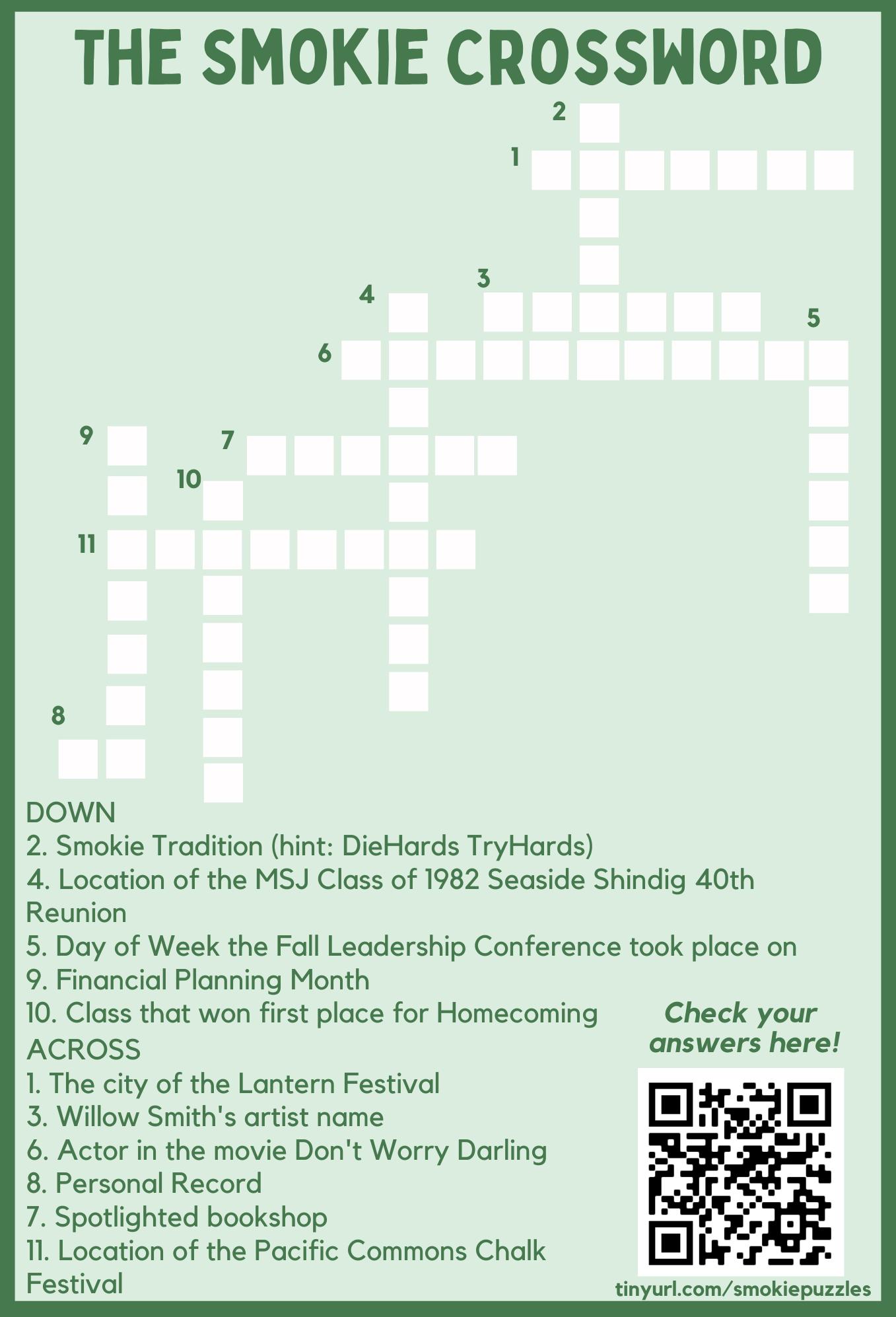
With the support of her coaches and par ents, who pushed her and constantly looked for ways to help her improve, Woo’s talent quickly emerged.
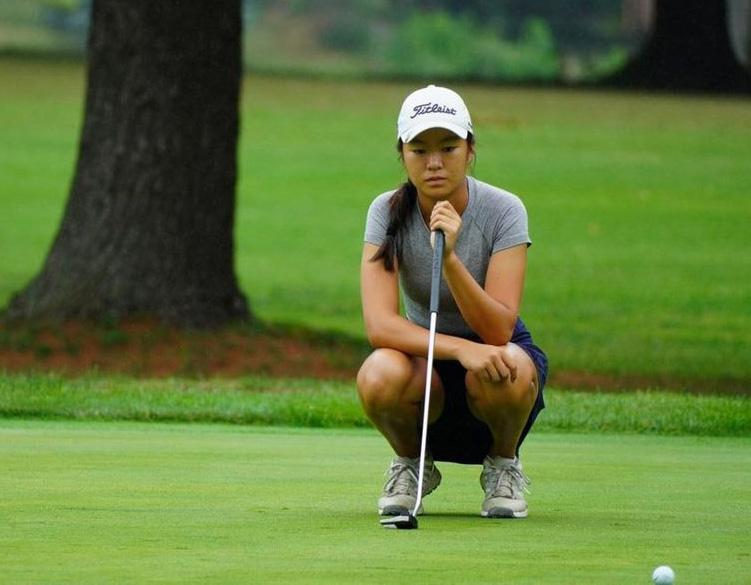
Unfortunately, when the coronavirus pan demic hit in 2020 and most golf ranges closed, Woo had no choice but to put a hold on her regular training. Despite this, she and her fam ily persevered and came up with ways for Woo to train at home. While in quarantine, she was able to practice by hitting balls into a net set up in her garage.

However, like most athletes, the long months with only at-home training had taken a toll on Woo. “After COVID I kind of went into a slump, and I was playing really bad,” Woo said. Regardless, she trained even harder than before, refusing to let this setback control her as a player. “I just kept going and eventual ly got better,” she said.
Woo’s determination paid off, as she re turned in her freshman year at the top of her game. Last year, she joined the MSJ Varsity Girls Golf Team as a freshman and earned the title of MVAL Girls Golf MVP. She also qualifed for the United States Women’s Am ateur Golf Championship, the leading golf tournament in the US for female amateur golfers. This was Woo’s most memorable tour-
nament to date, as she recalls, “It was a really fun experience being able to play with college players.”
To compete at the national level, Woo trains for about three hours every day. Being a fulltime athlete and high school student taking challenging courses, Woo has nailed down a routine to balance her sports and academics. “I just try to manage my time well and plan ev erything out ahead of time,” Woo said. “[even though] it’s kind of hard.”
For other athletes serious about sports, Woo wants to remind them that the key to suc-


cess is to genuinely enjoy their sport. “I think something that’s really important is just to try to have fun,” Woo said.
“If you put too much pressure on yourself, you won’t want to do it anymore.”
In the future, Woo plans to continue do ing what she loves for as long as she can. She hopes to join a Division 1 golf program and play throughout college.


Despite the rush of adrenaline and excitement when it comes to playing a sport, there is a possibility of broken bones, fractures, and sprains. According to the National Athlet ic Trainers’ Association, a child is sent to the emergency room for a recreational or sports-related injury every 12 seconds, affecting both their academic and athletic careers. Stat ic and dynamic stretching paired with sports medicine can always ensure a healthy and safe workout, reducing the risk of accidents and injuries.
Broken bones, most commonly in the hand and lower extremities, only constitute 5% of all sports injuries according to a 2003 study done by American Academy of Pediatrics. There are many different types of broken bones; the most common types are compound and closed fractures. Compound fractures are fractures where the bones are exposed and break through the skin, mak ing them the easiest to diagnose. Closed fractures are much harder to diagnose because they have no distinguishable features to tell them apart from a sprain or dislocated joint, requiring the use of x-ray or MRI scans. Some symptoms of broken bones include abnormal or misshapen limbs, bruising, swelling, or bleeding in an area, limited mobility, and a feeling of numbness. If an athlete experiences any of these symptoms or believes there is reason for a fracture, they must head directly to the emergency room to di agnose and treat the injury as soon as possible.
Sprains make up more than 15% of athletic injuries and are the result of a tear in a ligament, a fbrous tissue that connects bones to each other, and are involved in 41.4% of sports injuries, per the Centers for Disease Control and Prevention. Based on the symptoms of the injury, sprains can be classifed into Grades I, II, and III, with each stage being successively rarer than the previous. In a Grade I sprain, the tissue is stretched with hardly noticeable swelling, causing some loss in mobility and strength. If the swelling is more noticeable — around the size of a baseball — and bruising is observed, the sprain is considered Grade II. A Grade II sprain re sults in a loss in range of motion, strength, and stability. In a Grade III sprain, which is the most severe, the ligament tears completely, and the athlete cannot move or apply pressure on the sprain. This injury can usually be healed with ice and compression for Grade I and II sprains, or a cast/brace for Grade III sprains, with rest for three to six months depending on the severity.
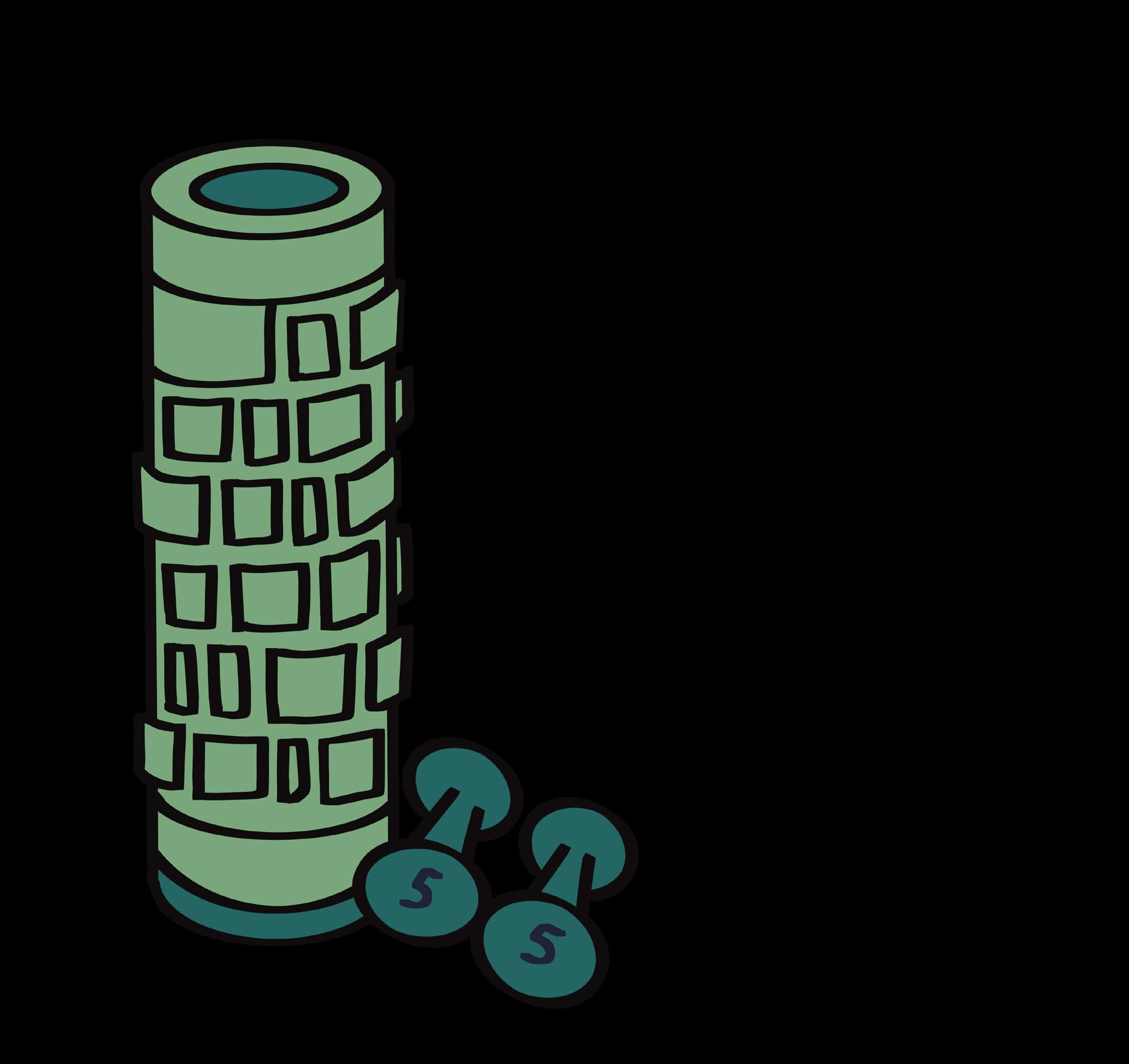
“The most common injury most athletes get while running would be shin splints. This can be caused from either strain on the shin area with a sudden increase in exercise or it can be caused from things like unsupportive shoes. It generally happens from repeat ed stress on the shin bones.” — Var sity Girls Cross Country Co-Captain Senior Advika Govindarajan
“You might get injuries from overuse, or sud den injuries from getting pulled or getting hit, which can lead to con cussions. It is safer, that it’s in the water, but more dangerous, its very physical and people are throwing things at you in the water, there are both pros and cons.” — Boys and Girls Water Polo Coach Ryan Tang

Stress fractures, constituting 10% of all sports-related injuries according to one study by the New England Baptist Hospital, are small cracks in the bone caused by repetitive motions, such as repeatedly jumping up or down or the foot striking the ground. This injury often occurs in new athletes who jump into a new sport and start training before their body has reached a certain athletic threshold, where they can handle the wear and tear that comes with the sport. The most common places of stress fractures include the foot, ankle, hip, and the ribs, because the constant weight pushes past the limit of how much those bones can self-repair, leading to small cracks, and are especially common in athletes running long distanc es. Thus, high impact sports such as gym nastics, tennis, and track and feld pose a much greater risk of getting stress fractures to athletes. Symptoms of stress fractures include pain when the limb is in motion as well as swelling. If left untreated, it can often lead to chronic pain and at risk of additional stress fractures. This injury can be treated at home with ice and a few months of rest. For athletes who wish to return to form as quick ly as possible, surgery and recovery takes 6-8 weeks to heal in a cast or foot brace.
While most sports-related injuries are resolved in the short-term, some can leave a lasting impact on the athlete, especially chronic ones. Take tennis elbow, a condition where the tendons of the elbow are overused and over loaded to the point of causing pain or weakness, as an example: while it can go away by itself, it may lead to arthritis in the future due to the deteriora tion of the tendons in the elbow. Even if there are minimal physical conse quences, some injuries can have a mental impact as well. In a more extreme case, when an athlete suffers an intense physical setback like a broken arm, it can leave a gap in the athlete’s expectations of their ability. For some athletes, “There’s always a bit of a mental re-adjustment … [because] it’s diffcult to adjust to having a mental aspect that something that was pretty routine might be dangerous now,” MSJ Boys and Girls Water Polo Coach Ryan Tang said.

Generally, braces are medical devices that support, protect, and realign different parts of the musculoskeletal system. They can be used to aid in the healing process of anything from a sprained ankle to a broken wrist and can also be used for injury prevention. A wide variety of braces used for different parts of the body are made to immobilize the joint or part of the body being protected to prevent it from incurring further injuries. According to a study by the University of Wisconsin in 2011, athletes that wear ankle braces reported 68% less injuries than those that did not wear them. However, in cases of high impact injuries such as broken bones or fractures, braces should not be the first or only thing the patient looks to. For quick on-the-spot solutions, athletes can try taping or wrapping their injuries which can be helpful, but only for a short period of time; according to Fort Memorial Hospital, they lose 4069% of their effectiveness after 10 minutes. Athletes should first consult with a medical professional as braces are only one step to the healing process.

Physical therapy is any kind of medical attention that involves physical movements and improves mobility, relieves pain, or restores physical health. Physical therapy can help reduce symptoms of nausea and dizziness among a variety of people and injuries. Depending on the situation, different kinds of physical therapy can be more benefcial than others: aquatic physical therapy uses the reduced gravity feeling to make movement easier, hand ther apy specializes in arm or shoulder injuries, and vestibular therapy helps reduce headaches. Some of the exercises commonly practiced in physi cal therapy include rolling out muscles with foam rollers, lifting light weights, and using resistance bands. Physical therapy is commonly used after the ath lete has mostly recovered from the injury or surgery, but has not regained full mobility. Many types of physical therapy aim to increase blood fow, which is crucial to the body’s healing process. Physical therapy can be extremely helpful, but athletes must be cautious when deciding to use physical thera py; if an injury is not completely healed, the repetitive movements from the therapy sessions could cause more injuries, prolonging the healing process.
The majority of athlete injuries occur during practice and are often preventable, like shin splints, or a pulled/strained muscle. To reduce the risk of injury, athletes often do dynamic stretches, like leg swings, lunges, and arm circles, before a workout, which engages the relevant muscles and tendons so that they are prepared for exercise. In addition to stretches, warming up before a workout is key to preparing the body for intensive exercises, as it can increase body temperature and blood fow to the muscles. Warming up typically consists of exercising at a lower intensity before the planned workout. For example, a runner would do a few minutes of jogging before a long run, and a swimmer a few slow laps before their full training routine Although stretching and warming up don’t completely eliminate injuries, they have been linked to a reduced rate of injury. According to a study on aerobic dance instructors by the Democritus University of Thrace, 89% of those who warmed-up for 5 minutes were injured, compared to only 26% of those who warmed-up for 15 minutes.



 By Anushka Vasudev & Aaron Zhou Staf Writers
By Anushka Vasudev & Aaron Zhou Staf Writers

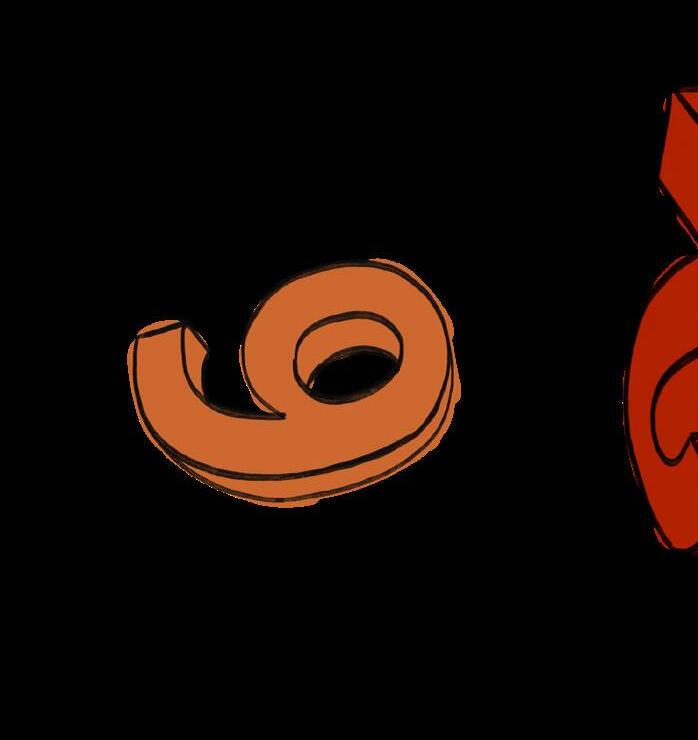
Lifter A has a bench press record of 200 pounds, while Lifter B’s record is 175 pounds. Yet, Lifter B’s deadlift record is 50 pounds higher than Lifter A’s. Who is the stronger lift er? Can these statistics accurately answer this question? While numbers have often been used to quantify success in sports, they don’t tell an athlete’s complete story. Statistical compari sons aren’t just seen with athletes in competi tions, but also during casual workouts indoors or outdoors, often to a harmful extent. Num bers are certainly one way to measure skill and ability, but they are not the only way. Rather than just defning the value of exercise statis tically, athletes should use numbers as a sup plement to track progress and view exercise as a journey to become stronger physically and mentally.











Being too fxated on using numbers as a means of improvement causes athletes to lose track of their personal goals and achievements. For example, if a student runs a 10 minute mile in physical education while the gold standard is eight minutes or less, the quantity “10 minutes” should not defne their capability and perfor mance. This mindset fosters a black and white environment in which people believe that they have progressed only by reaching a certain number.
Emphasis on numbers also causes athletes to ignore physical signs from their bodies, such as soreness, heart rate, and muscle aches, which can risk injury. Though ath letes are constantly tempted to beat their personal record (PR), it is important to real ize that everyone has their physical limits. Set ting another person’s high PR as an expectation for themself will only lead to overexertion and burnout, which increases the likelihood of in jury. Moreover, a number-centric environment unnecessarily pressures athletes into feeling like they should have run a few seconds faster,
done one more pull up, or lifted a heavier weight.
As athletes feel pres sure to improve, they become rest less and discour aged when they
equally important for im provement.
Alas, PRs are often a way for people to set goals and mea sure their im provement in a tangible

that a single value encapsulates an entire work out, when in reality factors such as technical abilities, skill, and mentality, also play a role in improvement.
“[Diferences in physical limits are] especially important to remember at youth level (under 18), when all athletes are developing and the rates of development being expe rienced are diferent for each indi vidual.”
— CORRECT MY PLAY, A SPORTING MENTAL HEALTH RESOURCEAthletes must realize that attaining personal goals are not solely dependent on gaining new PRs. There are other ways to track progress and improvement that don’t involve just look ing at the numbers on the side of a weight or at the time on a stopwatch during a run. Sim ple activities such as refecting on a workout by evaluating what went well, what was moti vating, and what can improve allow athletes to qualitatively judge a workout and their prog ress. Additionally, measuring heart rate, moni toring one’s sleep schedule are excellent meth ods to enhance performance in the long run.
progress. Not doing so can perpetuate an un healthy mind set
Students should be critical of the way they measure improvement and place more value on having a mindset that encourages learning and personal growth, and not just the numbers. Realizing that numbers and comparisons aren’t the only way to determine improvement and progress will help improve an athlete’s perfor mance in the long run.
On Sunday, Oc tober 9, Interact District 5170 hosted its annual Fall Leadership Conference (FLC) at Inde pendence High School in San Jose.
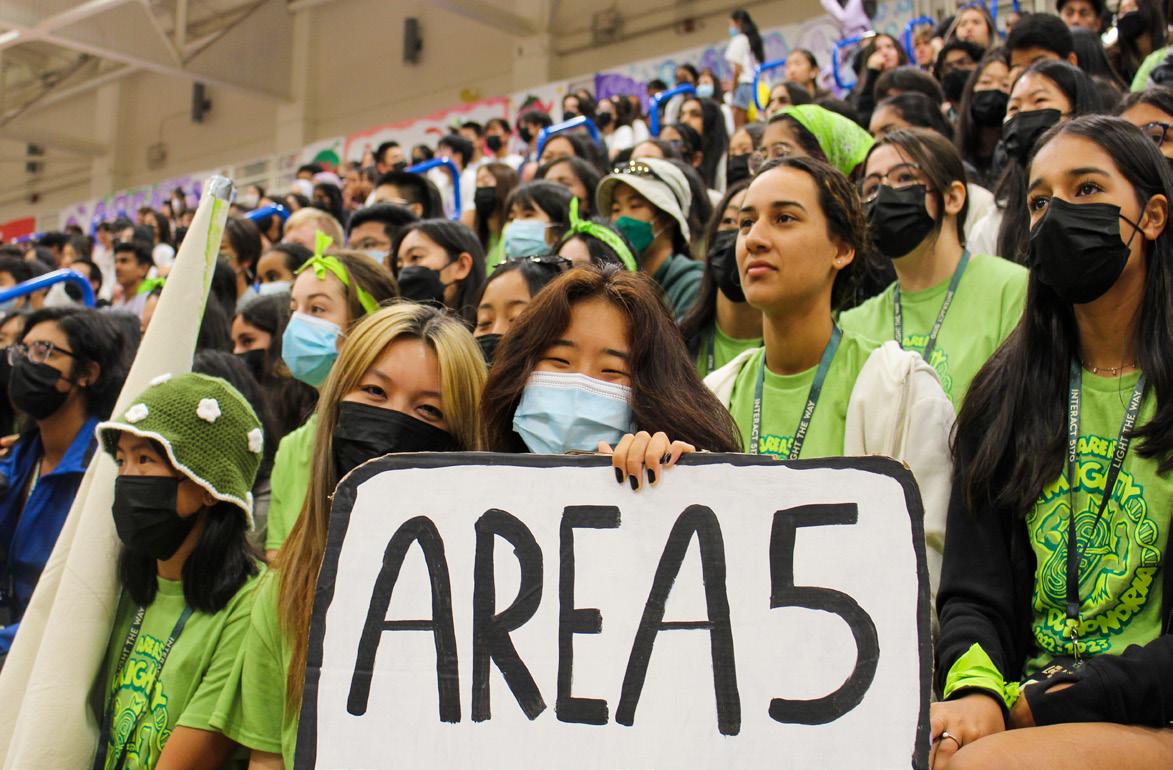

MSJ Interact Club attended this annual leadership event, along with thousands of high school students and Interactors from across the Bay Area. With an array of workshops, service project presentations, and networking opportunities, FLC kicks off the year for Interact District 5170, the largest and most prolifc Interact district in the world. As the event began at 9 a.m., attendees roamed excitedly around the auditorium, decked out in their Interact Area merchandise and mascots. Following a spirit rally and introduction led by Daybreak District Council (DC), the student-led governing body of Interact District 5170, the 2022-23 International and Community Service Projects, respectively named The Ripple Effect and Cultivating Our Communities, were revealed. “This year’s DC wanted to teach high schoolers all over the Bay valuable leadership skills, as well as educate them on District 5170’s two main projects this year as we prepare to help the fght against unsanitary water and food insecurity,” DC Co-Outreach Coordinator
The remainder of FLC consisted of a rotation of four leadership workshops that radiated with an enthusiastic dedication to service and community, with Interactors brainstorming service events, practicing their networking skills, and learning more about the charity initiatives for 2022-23. As FLC came to a close, attendees exchanged social media contacts and took pictures with each other, forming connections with fellow Interactors. “Every year, FLC is such an incredible experience, and this year was no exception,” MSJ Interact Co-President Senior Sinchana Nama said. “I’m so excited for the Interact year to come.” ▪

Artists from all over the Bay Area, recruit ed by artist and organizer Lisa Jones, participated in a family-friendly chalk festival from 12 - 3 p.m. on October 9 at The Block in the Pacifc Commons Shopping Center. Stunningly detailed dry pastel murals, in diverse creative styles from realism to cartoon, attracted excited shoppers and residents. At the Kids Chalk Zone, children cheerfully designed their own mu rals while face painting and receiving balloon twisters animals.
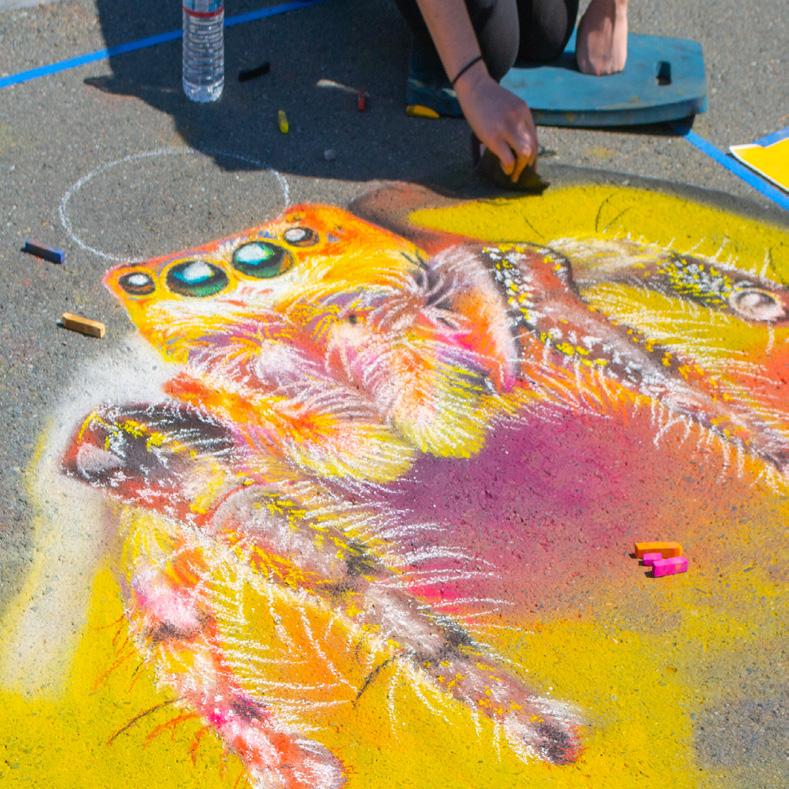


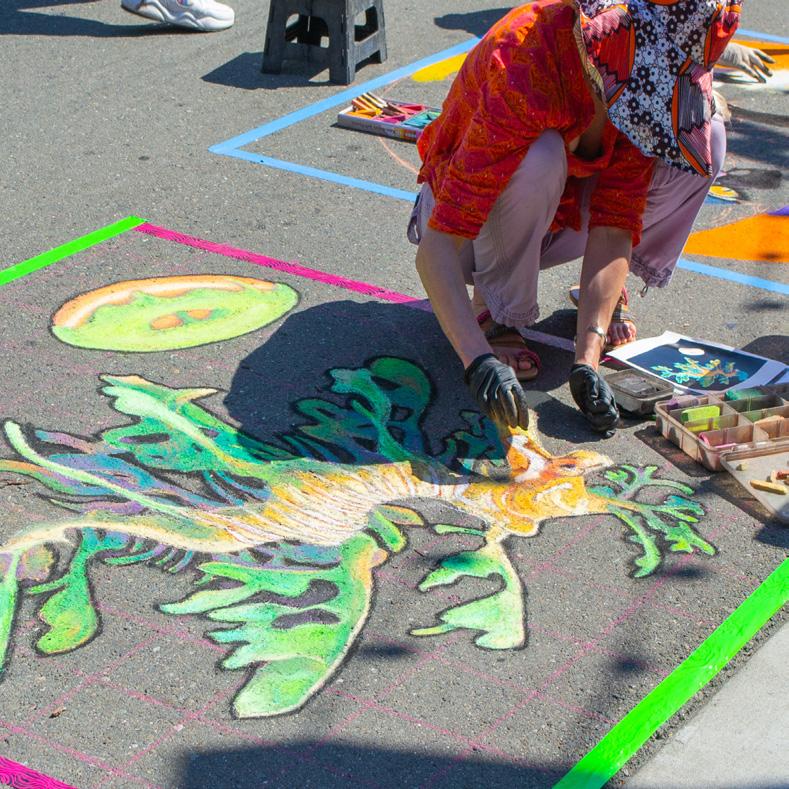
Artists with various levels of expertise and styles shared their experiences. Artist Clifton Gold, a three-time artist of the chalk festival discussed their unique process as a col orblind artist. “I do about 20 of these [murals] a year, all up and down California. My process is a little bit different than everybody else’s be cause I’m colorblind, which is why I work in more of a graphical style,” Gold said. Gold’s mural amused many attendees, with a semi-realistic yet ultra-detailed panda ador ably poking through the borders of the mural.
Lively music pouring through speak ers matched the festival’s bustling ener gy. Parents also enjoyed the refreshing festivities after being cooped up inside during the pandemic. “My kids really enjoy drawing and art in general so I thought it’d be a good opportunity [after] COVID times you know when they were wrapped up in their house. The most important thing is that [my kids] had fun drawing on the ground.” parent Monty Singh said.


Jones expressed her love for the spontaneity of chalk art and how the festival aims to serve the com munity. “It’s really art for art’s sake … a live per formance if you will. The community can inter act with us and we love that. It’s just an effort to bring people together to enjoy art,” Jones said. ▪

